PEOPLE PLACE POWER PEOPLE PLACE POWER PEOPLE POWER Jess Turtle p.1 Hannah Ishmael p.4 Sophia Labadi p.7 Sharon Ament, Asif Khan, Paul Williams p.10 Judit Carrera p.13 Gus Casely-Hayford p.16 Museum Detox p.18 Larry Achiampong and Megan O’Shea p.20 Stephen Pritchard p.26 Claudia Zaldívar p.29 Pedro Fiori Arantes p.33 Cláudia Rose Ribeiro da Silva p.38 Tom Butler p.41 URBAN PAMPHLETEER #10
Urban Pamphleteer # 10: Museums, Cities & Cultural Power
We are delighted to present Urban Pamphleteer # 10 In the tradition of radical pamphleteering, the intention of this se ries is to confront key themes in contemporary urban debate from diverse perspectives, in a direct and accessible but not reductive way. The broader aim is to empower and inform citizens, profes sionals, researchers, institutions, and policy-makers, with a view to positively shaping change.
#10 Museums, Cities & Cultural Power
Starting with the Museum of London’s upcoming move to West Smithfield, this issue explores the relationship between museums and urban areas from a variety of viewpoints and locations glob ally. Inserting a new cultural venue into an existing neighbourhood changes its social, cultural and economic dynamics. In recent decades, many new urban museums have been built with the aim of revitalising neighbourhoods and cities, raising significant questions about their local impact, and the roles and authority of cultural institutions in cities. The COVID-19 pandemic also prompted ques tions around their local significance when city centres emptied suddenly of tourists.
This issue brings together the voices of practitioners, activ ists and academics under the rubric of ‘place, people and power’ to consider how museums can reflect, represent and be of value to a wide cross-section of society in cities. Museum buildings are not just designed to store and display collections, but also as symbolic opportunities to support city branding, attract visitors, stimulate place-based regeneration, and build architectural reputations. Simultaneously as public institutions, they have a duty to reflect critically on their capacity to generate social change.
Museums have increasingly sought to attract a wider range of audiences to their buildings. These discussions consider what a museum created by, with and for its city entails. Museums have historically played a key role in shaping and representing particu lar ideologies and social value systems, and this continues today in relation to evolving public concerns around sustainability and the environment, economic inequalities and social justice, globalisation and marketisation, decolonisation and migration. Simultaneously, they are powerful actors in spatial redevelopment, the maximisation of urban property values, and the production of new land scapes of consumption. Our contributors consider how museums should engage with their position of power in society, interrogating the possibilities which they hold for the creation and management of new kinds of relationships and interactions in cities.
Monica Degen, Clare Melhuish, Lauren Parker
THE CITY AS A SITE OF DIRECT ACTION
Above: Museum of Homelessness protest outside the Home Office, London: David Tovey, 2020.
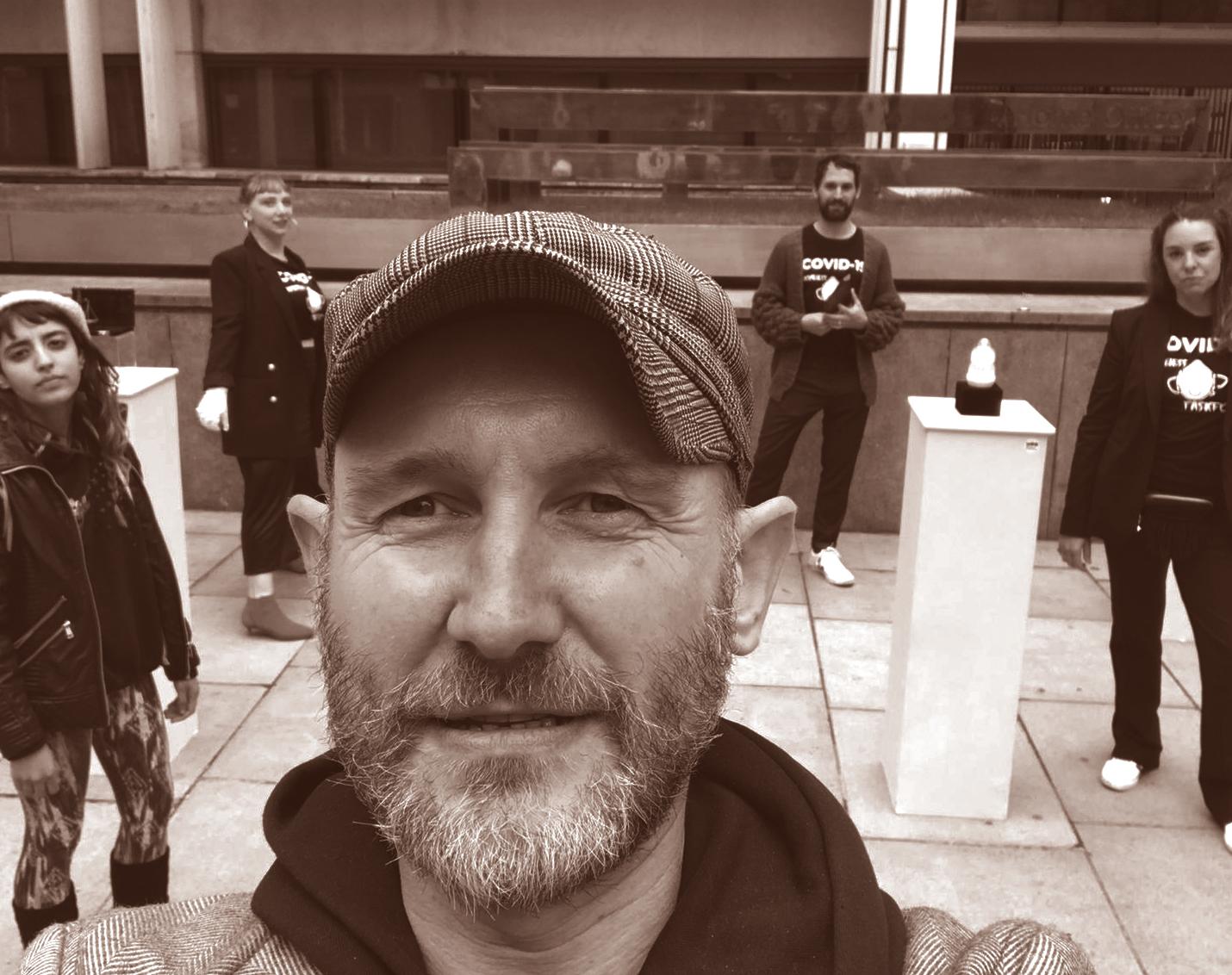
Left: Volunteers take supplies to the street in lockdown, May 2020: Jessica Turtle.

Despite a heroic effort to bring people into safety during the coronavirus pandemic (COVID-19), deaths in the homeless community increased. When we published our Dying Homeless Project findings in 2021, the UK government issued a press release stating that they had reduced rough sleeping by 37%. We responded by creating temporary installa tions in Trafalgar Square in Central London to mark each life lost and holding a com munity vigil to mourn those we have lost.
Our museum follows mutual aid traditions, utilising the urban form as a site of direct action and collective solidarity.

We are mourning the fact that deaths in our community have increased by 80%
over two years (barely any of these deaths were from COVID-19 itself). We are dealing with an epidemic of inequality, trauma and poverty, both on a structural level and in the everyday. We believe museums must stand against this. In 2020, we made a mu seum outside the Home Office to challenge the ‘hostile environment’ — a series of im migration legislature and policy changes introduced since 2012 — that has not only caused deaths and misery for homeless migrants but has also emboldened racists and far right groups.
Why is a museum challenging the government? The Museum of Homelessness (MoH) was born in 2015 and took its first steps in a landscape of austerity, bedroom taxes and food banks. We don’t yet have our own building, but metaphorically we are located in an increasingly hostile environment for migrants, ethnically di verse people, poor people and disabled people. Homelessness is a symptom of this inequality and this has shaped what the museum does, led by what the community needs. Our museum follows
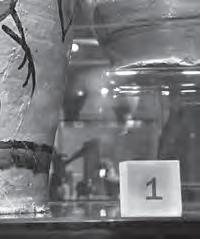
Jess Turtle
mutual aid traditions, utilising the urban form as a site of direct action and collective solidarity.
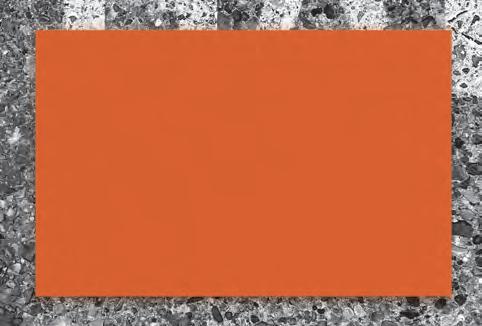

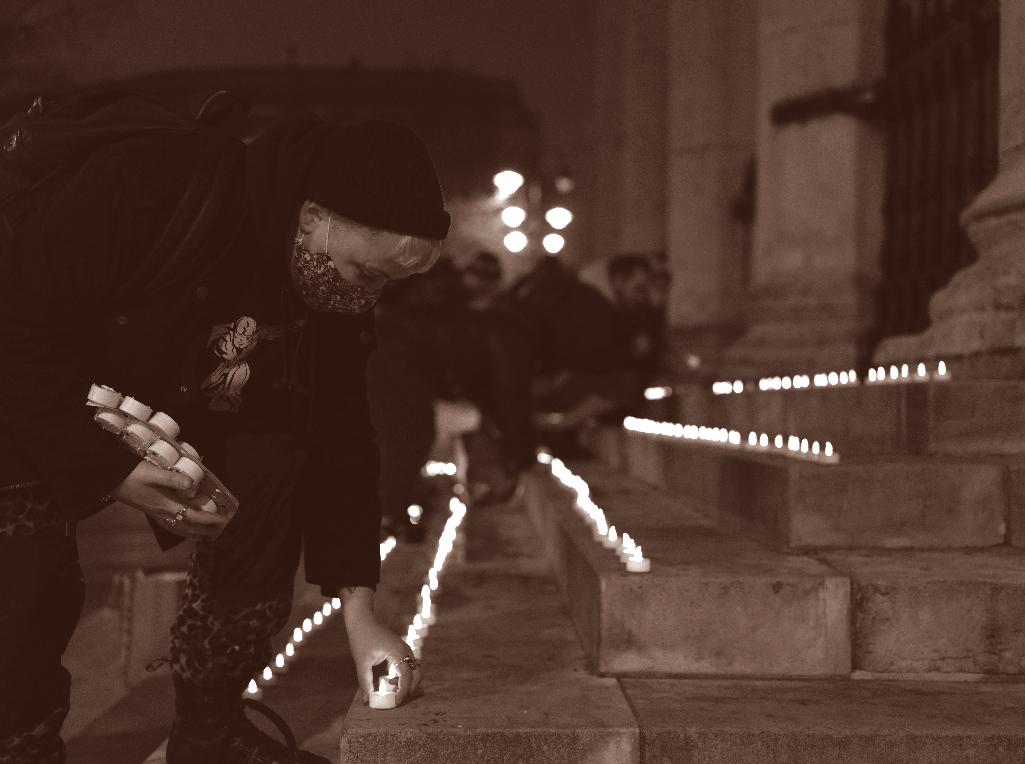
The objects are often powerful acts of resistance: a baby’s bottle that symbolises an undocumented mother’s struggles in the asylum system; a glass that symbolises the trials and blessings of being in recovery; a walking stick that is a metaphor for creative survival in a life less ordinary.
Collectively, since the pandemic hit, our Homeless Taskforce crew has organised doggy dispatch for squat dogs; taken sunscreen out in the heatwave; distributed hundreds of thousands of meals and care packs; set up street vaccine clinics; and sourced cardboard when none was to be found in London's West End. We spent April 2020 distributing a thousand Easter eggs across London, and Christmas morning in Tra falgar Square with hot drinks and chocolate coins. We’ve fought evictions and intervened against police and council harassment and far right racism. We’ve held each other’s mental and emotional balance when formal services were not an option. It has been intense. Every one directly involved with MoH has survived — against the odds — yet we are also full of grief that we haven’t saved as many lives as we had hoped we could when the pandemic started.
Justice-focused work is woven into all of our processes, including how we collect and document tomorrow’s history. With each object we collect, we take a testimony. The story is then performed when the object is shared with our audiences. The objects are often powerful acts of resistance: a baby’s bottle that symbolises an undocumented mother’s strug gles in the asylum system; a glass that symbolises the trials and blessings of being in recovery; a walking
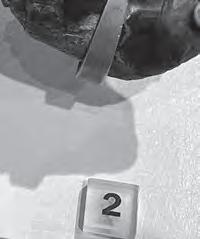 The City as a Site of Direct Action
Carla Ecola, Director of Outside Project, lays candles at Museum of Homelessness vigil, 2021: Anthony Luvera.
Museum of Homelessness COVID-19 Homeless Taskforce in May 2020: Matt Turtle.
The City as a Site of Direct Action
Carla Ecola, Director of Outside Project, lays candles at Museum of Homelessness vigil, 2021: Anthony Luvera.
Museum of Homelessness COVID-19 Homeless Taskforce in May 2020: Matt Turtle.
stick that is a metaphor for creative survival in a life less ordinary. These are the objects we placed outside the Home Office in an act of symbolic defiance when far right groups, emboldened by the racism at the heart of government, went migrant hunting in the COVID-19 hotels that we had helped to set up. This work is important for today, but also for the future. By holding these objects in our collection, we are carrying out work that those of us involved in the founding of the museum won’t live to see the fruits of. When historians look at what happened with homelessness during 2020, they will be able to access direct unfiltered ac counts from people who lived through it. If you look at archives and collections from a hundred years ago, those accounts are not included.
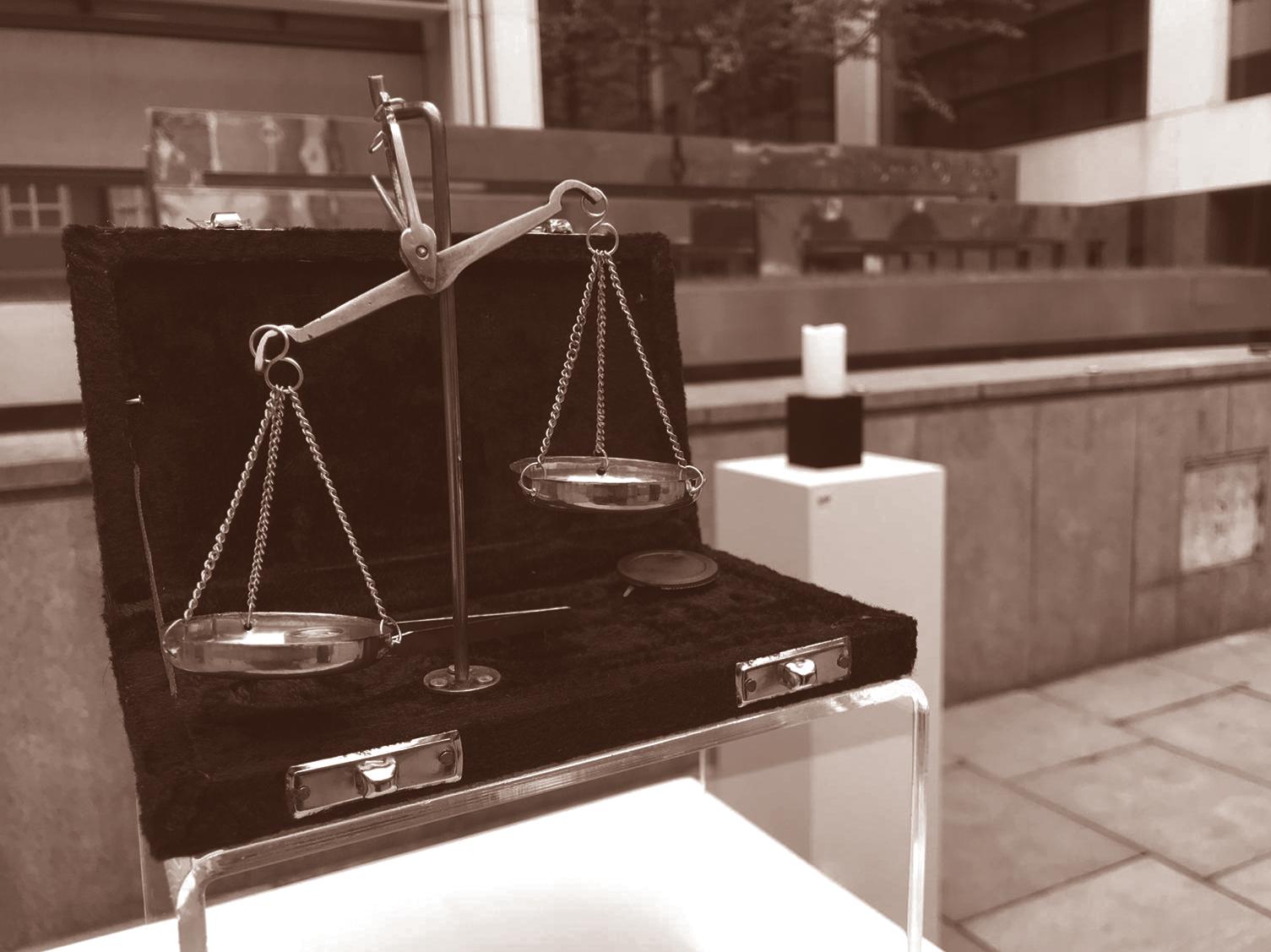
We must reframe the narrative. We also need to ask hard questions, like the one we opened this piece with; why are so many people dying preventable deaths when they come into the homelessness system?

We must reframe the narrative. We also need to ask hard questions, like the one we opened this piece with; why are so many people dying preventable deaths when they come into the homelessness system? An independent museum, shaped by its community and implementing rigorous research, documentation and interpretation is in a good position to do these things. We will continue to make a space of creative resistance, adapting as we go, for as long as it is needed.

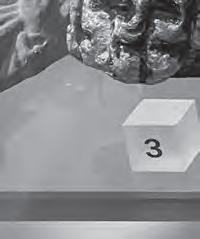
PEOPLE PLACE POWER
Jess Turtle Co-founder, Museum of Homelessness.
Museum of Homelessness street museum installation , London 2020: Daniela Sbrisny.Museum of Homelessness collection displayed outside the Home Office in August 2020: Richard Matthews.
ON THE POWER OF MONUMENTS
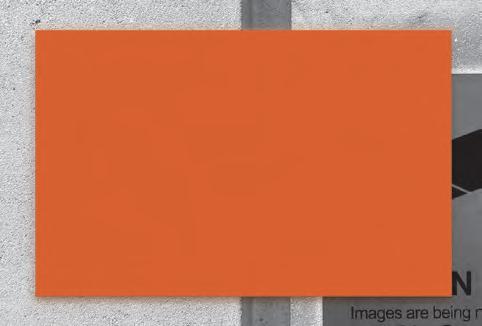
When you exit Brixton Tube station in South London and turn left towards Lambeth Town Hall, you will come to the grassed, pedestrianised area of Win drush Square. As we continue to commemorate Windrush Day each June, it gives us a minute to pause and reflect on the significance of naming and memorialising, and the role of communities in shaping our understanding of belonging.
An examination of the naming of Windrush Square and the moniker given to the ‘Windrush Generation’ that represents the arrival of thousands of people from across the Caribbean from 1948 to roughly 1962, makes visible many of the tensions present in the desire to memorialise and commemorate alongside the selective acts of remembrance and forgetting.
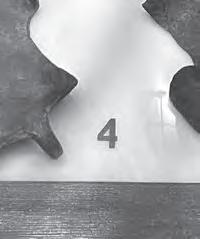
Many of the following observations I owe to public historian and blue badge guide Kelly Foster, who pointed out that most of the instances of me morialisation in Brixton are driven by the local community (in its widest sense) and what the community wishes to remember, rather than the Statedriven memorials more prominent in Central London. It is the local commu nity who often sustain the development and care of these memorials.
Most of the instances of memorialisation in Brixton are driven by the local community (in its widest sense) and what the community wishes to remember.
Turning briefly to the square formerly known as Brixton Oval and then Tate Gardens, Windrush Square itself was re-named in 1998 by a public vote to remember the people from the Caribbean who came to call Brixton their home. Thus, the renaming reflects the changing uses and community significance over time. On Windrush Square there is the grassed square itself and the associated landscape architecture including metal windrushes; fixed chairs and ironwork; a commemoration to the Sharpeville Massacre in South Africa of 1960; a statue of Sir Henry Tate (who gifted Tate Brixton Library, Streatham Tate Library and South Lambeth Tate Library to Lambeth); a war memorial to African and Caribbean servicemen and women; and the recently unveiled memorial, designed by Sir David Adjaye, to Cherry Groce who was shot and paralysed by police during a raid of her house in 1985 and which sparked the uprisings of that year.
Sited at number One Windrush Square is the building that is the home of Black Cultural Archives, a Grade II listed Georgian building once known as Raleigh Hall. Established in 1981 as the African People’s Historical Monument Foundation, the organisation was inspired by the work of African American activist and reparations campaigner Queen Mother Moore. Having estab lished her African People’s Historical Monument Foundation in New York, Moore came to England to discuss her ideas for a diasporic network of
Hannah Ishmael

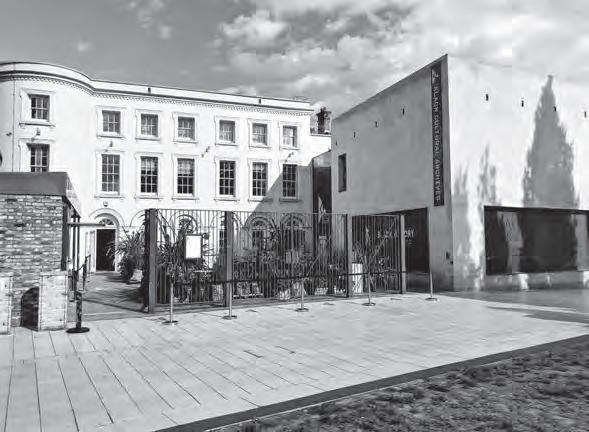

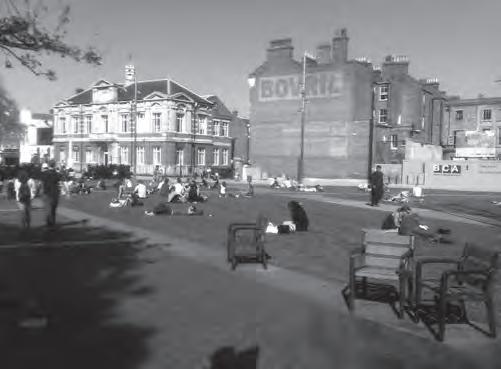

PEOPLE PLACE POWER
Windrush Square, Brixton: Felix-felix, 2006 (Public Domain).
Bust of Sir Henry Tate, Windrush Square, Brixton: Matt Brown, 2011 (CC BY 2.0).
Windrush Monument, Windrush Square, Brixton: Chris McKenna, 2011 (CC BY-SA 3.0).
Black Cultural Archives building, Windrush Square, Brixton: © Black Cultural Archives.
the Power of Monuments
organisations that would commemorate and memorialise those who had lost their lives during the Transatlantic Slave Trade, through the plantation system and colonialism, and systems of racialised terror across the world. The key aim of the foundation was to critically engage with the production of histori cal narratives, and also the underlying systems through which narratives are produced, within the archive. The founders set about finding a permanent home for the organisation, and Black Cultural Archives became a project of the African People’s Historical Monument Foundation in order to have a suit able, permanent building to house their growing collections. The act of reno vating and inhabiting a Georgian building speaks to the interweaving of the histories of enslavement with the broader narratives of Britain. Black Cultural Archives now occupies a space that connects to, and resonates with, impor tant figures in Britain’s Imperial past — Sir Walter Raleigh (although there doesn’t appear to be a direct connection) and the statue of Sir Henry Tate of Tate and Lyle, who made his fortune from the cultivation of sugar in the Caribbean — and the symbolism of Windrush itself.
In their desire to create a monument, the founders of Black Cultural Archives were attempting to create a permanent marker that speaks of the presence of Black communities in England, and a memorial to those lost (physically and metaphorically). It is important to situate the desire to create monuments within this aspiration to disrupt narratives, but also to be wary of the risk that monuments can come to symbolise monolithic ideas of the communities they represent.
The founders of Black Cultural Archives were attempting to create a permanent marker that speaks of the presence of Black communities in England and a memorial to those lost (physically and metaphorically).
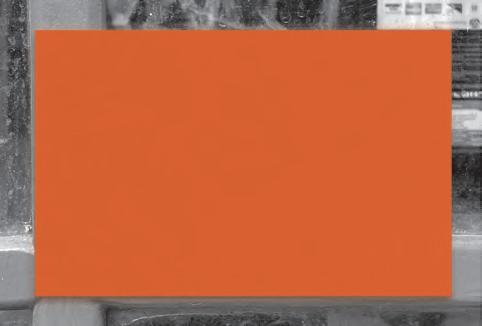
I want to end with a final quote by Nigerian author and playwright Wole Soyinka, who re minds us:
1 W. Soyinka, ‘Memory, Truth and Healing’, in I. Amadiume and A. An-Na'im (eds), The Politics of Memory: Truth, Healing and Social Justice London and New York: Zed Books. 2000, p.32
Hannah Ishmael Collec tions and Research Manager, Black Cultural Archives.
1

every landmark is a testament of history […] They are indices of truth, an essence and a re ality that offer any people, however impover ished, a value in itself, a value that, especially when rooted in anguish and sacrifice, may dictate a resolve for redemption and strategies for social regeneration.
Soyinka argues that whilst it is vital to guard against the essentialising tendencies of monuments, sometimes the very presence of a monument can be an important reparative marker. Given the origins of the African People’s Historical Monument Foundation — as a site to engage with the legacies of enslavement, migration and belonging — it is clear that Black Cultural Archives, as a monument, offers another important space to confront and disrupt the narratives of Black presence in the UK
On
Undocumented workers are invisible in the cityscape, yet they often perform some of its vital functions. Here I discuss what a museum created by, with and for its city entails.
MUSEUMS, UNDOCUMENTED WORKERS AND SOCIAL JUSTICE


From October 2010 to January 2011, the National Museum of the History of Im migration (NMHI) in Paris was occupied by 500 undocumented workers. It was one of the longest unauthorised occupations of a museum. The NMHI in Paris was opened in 2007 and aims to present immigration as a positive force for France — as long as it is legal and it leads to full integration of citizens.
These 500 sans-papiers represented a wider group of more than 6000 undocumented individuals who had been working — some of them for as long as ten years — in low skilled and physically difficult professions, such as in catering, hospitality or cleaning. Most of the occupiers were men from Mali and Senegal.
The occupation corresponded to a wider protest against the French gov ernment’s failure to implement guidelines that would provide a simplified and unified criteria for the regularisation of undocumented workers who had a work contract with an employer either full- or part-time. The aim of the occupation of NMHI was also to negotiate for the unified and harmonised treatment of regularisation dos siers, and obtain the regularisa tion of all working sans-papiers who fulfilled the official criteria. The occupation was coordinated by a trade union called the General Confederation of Work ers (confederation Générale du travail) in cooperation with nine other organisations.
By occupying this immigration museum, these workers made the point that positive immigration is not only a phenomenon of the past, as presented in the museum, but of the present as well.
The NMHI was chosen as a symbolic space. By occupying this immigration museum, these workers made the point that positive immigration is not only a phenomenon of the past, as presented in the museum, but of the present as well. The occupation of such an open space also aimed to make visible to the public the existence of working sans-papiers. Most frequently the term sans-papiers is associated with immigrants fighting for their residence permit on humani tarian grounds. The fact that undocumented immigrants can be workers with, for some, full-time contracts is a reality that had been obscured until this recent movement and occupation.
As part of my research,1 I wanted to understand how this occupation had been represented within the museum. Although there had been plans to do so, the occupation is not mentioned
Sophia Labadi
London: Routledge. 2017
at all in the permanent exhibition, called Repères (landmarks), that was re vamped in 2014. During my regular visits to the museum, I was continuously referred to a small glass cabinet (see photo), away from the permanent exhi bition, for information on the occupation. The cabinet forms part of a wider display on the history and organisation of the museum, although it is difficult to determine why this case was not included in the permanent exhibition. The conservator of the eth nographic collections who prepared this glass case stated that the cabinet’s location made sense, as the occupation was one event in the history of this museum. It thus needed to be presented in the section on the history of the museum. However, the peripheral location of this small cabinet and the lack of references
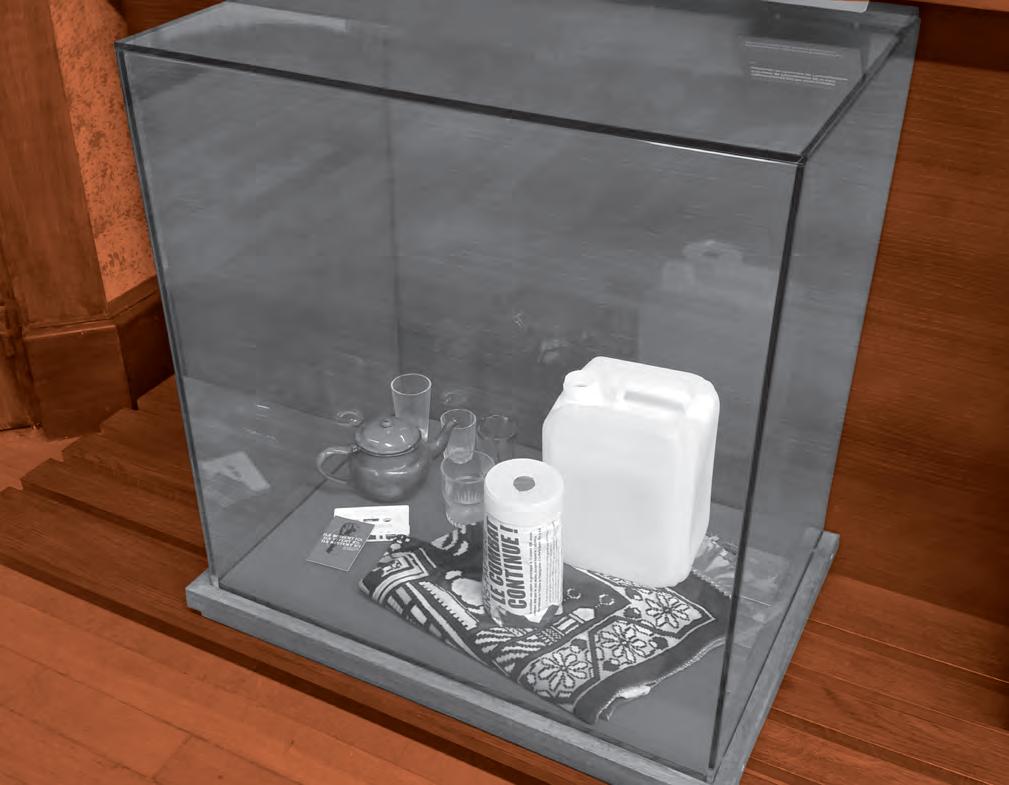
Sophia Labadi Professor of Heritage , University of Kent.
 1 S. Labadi, Museums, Im migrants and Social Justice.
Museums, Undocumented Workers and Social Justice
Glass cabinet displaying objects from the occupation of the NMHI: Sophia Labadi, 2015
1 S. Labadi, Museums, Im migrants and Social Justice.
Museums, Undocumented Workers and Social Justice
Glass cabinet displaying objects from the occupation of the NMHI: Sophia Labadi, 2015
to the working sans-papiers movement in the permanent space of the mu seum highlights the uneasiness of the museum staff to deal with this occupa tion, and also with contemporary migratory phenomena.

Even more than an uneasiness, this peripheral location also suggests a refusal by the museum to recognise the importance of this occupation and of the phenomenon of undocumented workers — maybe to respect the government’s position, which funds this institution. This could also be a strategy by the museum to prevent any further occupation of the museum in the future. In any case, this approach has resulted in a level of censorship that is clearly demonstrated by the choice of material displayed in the glass cabinet, which contains objects left by the immigrant workers when the occupation came to a forced end.
The objects focus on the ‘social’ aspect of the occupation and include a teapot, a jerry can to carry water, a prayer mat and a tape. Those objects were selected because they illustrated how life in a community was orchestrated during this occupation. However, this presentation is biased and presented in an unethical manner for two reasons. First, it was prepared without the knowledge or the participation of any immigrant worker, trade union or NGO involved in the occupation. Second, not one of the artifacts on display refers to the trade union or any other organisation that coordinated the movement, even though immigrant workers left behind many leaflets, badges and stick ers displaying their logos. The display thus perpetuates the traditional stereotypical image of immigrants as non-workers who are detached from politics and lacking any substantial support network.
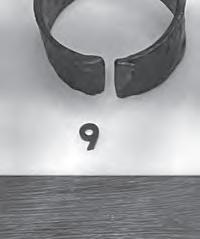
A result of the occupation is that it helped to speed up the delivery of residence permits. However, the main goal of the movement was to achieve a common and harmonised ap proach in the treatment of all regularisation dossiers, yet of ficial figures reveal that there remains a level of arbitrariness in the treatment of these dossiers. Therefore there have since been further strikes to try to achieve better treatment for all sans-papiers workers. The occupation of the NMHI had very mixed practical results for immigrant workers.
The lack of references to the working sans-papiers movement in the permanent space of the museum highlights the uneasiness of the museum staff to deal with this occupation.

PEOPLE PLACE POWER
Sharon Ament, Asif Khan and Paul Williams in conversation
REINVENTING MUSEUMS: THE LONDON MUSEUM
MD Could you explain why the Museum of London is moving to a new site at West Smithfield and your ambitions for the new museum?
SA We found ourselves at London Wall in 1976, but that location and building is no longer adequate for a museum, in fact, it’s probably the antithesis of our new museum design. Recently, we were presented with the opportunity to relocate, recreate and be reborn in a series of market buildings that will be the new London Museum, located in West Smithfield, right in the City of London and very close to St Paul’s Cathedral and Tate Modern. It’s a remarkable opportunity to have a museum that flows into the streets, for people to walk through, and in fact we do have a street going through the museum and a train line. London takes place on the street, and West Smithfield is probably the most hyperbolically 24-hour part of London.
MD What is distinctive about the ways that the London Museum will connect to its local area and with the people who live, travel or work there?
AK Since the beginning of its documented history, almost a thousand years ago, Smithfield or Smooth Field has communed Londoners in enormous numbers. From fairs to executions, prayer to celebrations, healing to market trading; it all happened here at a grand scale. Distances along the Great North Road to Edinburgh were even measured from here. This
This text is based on a conversation 'A New Museum for London' that took place as part of the Museums, Cities, Cultural Power symposium, between Monica Degen (Brunel University London) and Sharon Ament (Director, Museum of London), Asif Khan (Asif Khan Studio) and Paul Williams (Stanton Williams).
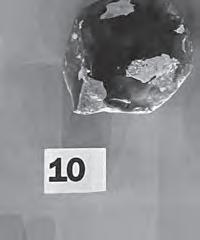
Stanton Williams as lead architects, with Asif Khan and conservation architect Julian Harrap, are transforming the historic West Smithfield General Market and Poultry Market into the new home for the Museum of London.
site was really one of the centres for London life, and that was our starting concept for the project — to re-instate its position in London. Horace Jones’ General Market building was designed to be public, permeable and most importantly, transformable. As all the nearby streets — with all their history — lead to the market building, our task has been to extend the permeability, bringing the street into this museum and the museum into the street. We have created many views through the walls and up and down through the floors, and enhanced the multiple entrances so the museum can always adapt with the times and seasons.
This is a building that’s an entire city block in size, it has about fifty shop fronts that are its external wall to the city. These will be one of the museum’s points of transaction — and form part of its identity. All of these shops are potential holders for content, for retail, for collaborations, and for partnerships. The museum isn’t a singular institute, it’s a coral reef, it’s where lots of other players can be part of this ecosystem. I don’t think there is any cultural institute whose facade is a changing high street of shops. There is so much potential for it to be more interesting than any other museum in the world.
PW This is a story of renewal and re-invention. The museum is being re-cast in two buildings — the General Market and
the Poultry Market — that, although currently derelict, are already embedded and woven into the fabric of the city. Existing between these two museum buildings is a canopied city street that will be owned and inhabited by the museum, and act as a major conduit into the surrounding neighbourhood. Understanding the impressive scale of the existing interior spaces, the atmosphere, the quality of the daylight throughout the day, the sounds, the touch, the tone and the mood is fundamental to the experience that the public is going to have. And the amazing physicality to that rawness that already exists on the site is certainly something the museum and the design team want to harness and celebrate. These two buildings and the street between them will allow Sharon and her team the flexibility to create an arena for public life, performance, installation, debate, and places for rest and reflection.
SA Instead of imposing a design we’ve eased our way into the buildings, and I think that makes for a really powerful design that I think will endure.
MD How are you integrating the new and the old, what are the challenges of doing something like this?
AK Sharon and her team have always spoken about the building as the largest artefact in the museum’s collection. We’re still discovering things because the building has to be picked apart in order to stitch it back together, to repair it and to make it good, as it was derelict for a long period of time. We are also embedding ideas and details that, while new, continue the tradition of transformability that is within this
building's DNA.
It’s a great voyage of discovery. We’ve often said that Horace Jones is the fourth member of the architectural team.
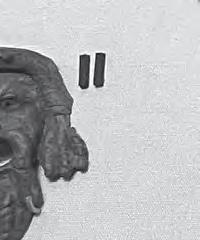
PW We are engaged in a dialogue with the building: decoding and translating its scars and traces, either cleaning and restoring the existing fabric or removing redundant elements in preparation for adding contemporary interventions when and if required, in order to create a clear organisational logic to the unfolding interior spaces whilst making the layers of history visible. For us, you need to understand the past before you can move forward with any certainty.
AK A lot of what you see and touch in the new museum will be materials that have a history, they have a sense to them, they’re dusty. There are so many stories in the building and the museum can tell these stories, they won’t get lost.
MD Sustainability is a really big issue for all buildings, and especially for this one. Could you tell us a bit more?
PW The initial decision taken by the museum not to procure a new building, but instead, reinvent and transform an existing set of derelict market buildings immediately achieves a significant embodied carbon saving.
SA Our intuitive feeling was that West Smithfield would be a fantastic place for the museum, and that was borne out by lots of analysis. It’s the centre of London and certainly it’s going to be one of the most connected museums: two train stops away from Paris. And Smithfield remains a viscerally compelling and evocative place. From the sound of the train through to the drip, drip, drip of water, and the residue of the former tenants all around.
PEOPLE PLACE POWER
When it was a live meat market in around 1849 — the live meat market closed in 1855 — 250,000 pigs were driven through London to West Smithfield and slaughtered, as well as 1.2 million sheep, and over 250,000 heads of cattle, not even counting turkeys and poultry. That in itself is just an example of the extraordinary stories that are embedded within the soil of West Smithfield.

PW We’re reusing and salvaging materials from the market wherever we can. If we can’t reuse them on site, they’ll be recycled or sold. And of course, this diverts as much of the waste from landfill as possible. We’ve been very astute in what we’ve kept, and, as a result of this ‘archaeological’ work, the museum now has a fascinating new range of salvaged objects, such as scales, meat hooks, spiral stairs. We have also retained a remarkable set of painted signage panels bearing the names of many of the traders who once worked in the buildings. These found objects really provoke the imagination and provide a strong link back to the buildings’ previous use and activities.
PW Beneath the General Market and the surrounding streets, lie the cavernous underground railway chambers with wonderful seven-meter-high brick vaults that will become the home to many of the museum’s objects. We would like to think that when the visitor
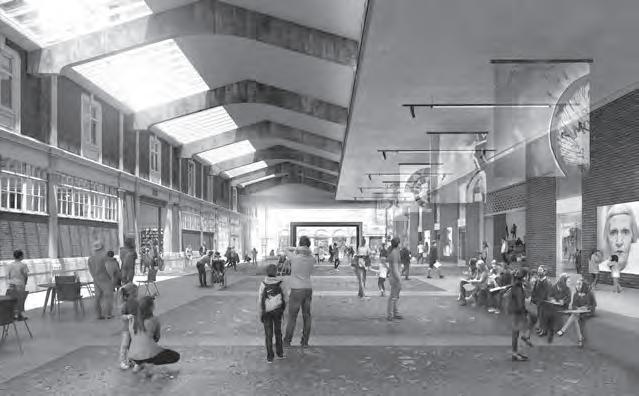
arrives at the top of the stairs in the General Market, and descends, as it were, through the sedimentary layers of London’s past, they will be conscious of arriving on the same level as the Roman settlements of 2000 years earlier.
MD Why do cities need museums?
AK The first museums were about siting your dynasty on the shoulders of great dynasties before you, it was a political move to demonstrate power by showing what artifacts and objects had been conquered or had been bequeathed. That’s a thread that connects a lot of museums in the world, and this is an important historical narrative. But museums now have a different function in the city — they can be civic spaces where the barriers to entry are much lower than to other spaces, allowing you to interact with other people from that city. They’re places of transaction but without anything being required of you. I think that maybe we need an alternative word for this new type of social or civic space. It’s a sort of freedom: I own it and I can contribute to it; it’s my neighbourhood; I’m both audience and performer here.
A place where that can happen makes a healthy city and happy people.
West Poultry Avenue image: © Stanton Williams, 2020 .
Judit Carrera
The Centre for Contemporary Culture of Barcelona, colloquially known as CCCB, was founded in 1994 and is a multi-disciplinary cultural centre based in Barcelona with a focus on urban issues. Its foundation coincided with the Olympic Games in Barcelona, at a time of huge ur ban transformation in the city and following the first democratic elections after 40 years of dictatorship. It is housed in a for mer alms house in the neighbourhood of el Raval, Barcelona’s former red light district, which remains a complex and disadvantaged inner city neighbourhood.
THE CENTRE FOR CONTEMPORARY CULTURE BARCELONA: LOCALLY ROOTED WITH GLOBAL LINKS


Architecture is fundamental to the CCCB. It is crucial that museums and cultural spaces have a building that reflect their principles. Our basic principle is openness. We’re fortunate to have a building that is completely open and porous so that people can walk though and that is well connected to its neighbourhood. It is important when we conceive of new museums or cultural spaces to view their architecture as a tool for the museum. For ex ample, our open space is used by families and young people who come to a familiar setting to take part in our programs. The CCCB space creates moments where strang ers meet and through which the city becomes a laboratory.
We view culture as a force for urban transformation by understanding ‘culture’ as a way of bringing together people from different disciplines and neighbourhoods in a space for encounter.
The museum was conceived as a centre devoted to cities and public space — informed by the belief that cities are the main social, political, anthropological and cultural spaces of moder nity. We view culture as a force for urban transformation by understanding ‘culture’ as a way of bringing together people from different disciplines and neighbourhoods in a space for encounter. With this idea we view culture as a force to improve the perception and everyday life of this neighbourhood and connect it to the other neighbourhoods in the city of Barcelona.
The neighbourhood we are situated in, el Raval, is located next to the Ramblas — Barcelona’s famous boulevard — and next to the port. Historically, it’s been the entry point for migration into the city, as it provides affordable housing and allows a starting point from which people then move to other neighbourhoods. El Raval is Barcelona’s most diverse neighbourhood — population has increased from 2% foreign migrants to almost 60% in 25 years. Now
We joined ten young migrants with ten local writers, and they worked together to create text or visual pieces that explained their own trip to Spain, exploring themes such as home, future and displacement.

el Raval hosts more than 70 nationalities in a small and compact area. These factors mean it is a paradoxical neighbourhood with a lot of potential and a number of challenges such as social exclusion, limited access to housing, poor quality public space, and religious coexistence.

The CCCB, as a museum in this ever evolving and complex neighbourhood, aims to bring people from different backgrounds together to encourage interaction and recognition. Our aim is to create programs that attract people from other neighbourhoods in town — the well-educated, middle class, or young people — while simultaneously promoting programs organised with and by the communities in the neighbourhood.
With this aim, we created a program during lock down that guaranteed that children could continue to go to school during the pandemic by offering our space as additional classrooms. The situation also gave us an amazing opportunity to transform the curriculums in the schools while creating a program that transformed us. For example, we had a wonder ful exhibition by South African artists, and we involved children from Raval’s schools in the curation
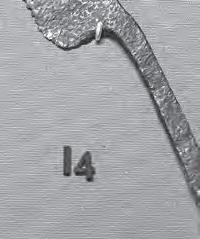 The Centre for Contemporary Culture Barcelona
Map showing location of the CCCB in el Raval, Barcelona: OpenStreetMap, 2022.
The Centre for Contemporary Culture Barcelona
Map showing location of the CCCB in el Raval, Barcelona: OpenStreetMap, 2022.
and production of that exhibition so they could get insights into how our cul tural centre works. More importantly, during history class, we discussed with students themes we also discussed during the curatorial process with our artists and curators, such as colonialism and imperialism. This was a way of involving them in the cultural life of the city through the CCCB, and through our programs.
In an exhibition called Trip to Mars, on the cultural history of Mars, the Red Planet, we involved an NGO that accompanies young migrants that have arrived in Catalonia without any family. We joined ten young migrants with ten local writers, and they worked together to create text or visual pieces that explained their own trip to Spain, exploring themes such as home, future and displacement. This was a way of introducing these young migrants to the cul tural space of a museum, a space that otherwise they probably would have never accessed.
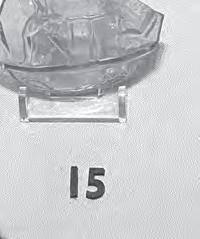
The pandemic has confirmed the importance of digital spaces to keep public conversations alive. Lockdown has further illustrated the importance of onsite and physical spaces for collective life. We could argue that the pan demic has actually accelerated a transformation that was already under way. Museums and cultural spaces need to be strongly locally rooted without losing their international links. These two aspects are not contradictory. Global conversation is essential, but at the same time if museums want to be relevant in ten years, for new local and international audiences, we need to find ways of engaging new audiences, new publics and new young people. We need to listen and not pre tend that we know everything. Cities are changing at a fast speed and in Barcelona’s case, the CCCB is trying to be alert to how urban life is changing. Our mission is to be alert and to listen to our immediate ecosys tem, to see how we can be use ful and meet the cultural needs of our city, Barcelona, and our neighbourhood, el Raval. This double role, of being a mirror and, simultaneously, a driving force, is what defines us.
Our mission is to be alert and to listen to our immediate ecosystem, to see how we can be useful and meet the cultural needs of our city … This double role, of being a mirror and, simultaneously, a driving force, is what defines us.

PEOPLE PLACE POWER
Judit Carrera Director, Cen tre for Contemporary Culture of Barcelona.
Gus Casely-Hayford
In building a new V&A in East London, we stand on the shoulders of the original radical practices of museology that the museum began with, and in a location where we can continue the tradition of invention and creativity.

BUILDING ON THE RADICAL HISTORY OF THE V&A IN A NEW MUSEUM FOR THE EAST END
When Henry Cole founded the Victoria and Albert Museum in the 1850s he sought to craft a museum that was driven by ideas of transfor mation. Driven by his beliefs in universal con nection between people, and across geography and time, he pioneered progressive ideas in museology that were radical for their time. To make it accessible to ordinary people it was the first museum to have late openings lit by gas light so that ordinary people could visit after their working hours, and it was the first muse um to contain a café that provided a space for rest and refreshment. Henry Cole believed that museums shouldn’t just be for academics and the educated middle class, but that they need to engage with and dynamise wider constituencies.
At a similar time Henry Mayhew, journalist and sociologist who founded Punch magazine, was surveying London and travelled eastward to the least fash ionable part of London where he was awestruck by what he saw. The East End was thought of during that period as a feral and poverty ridden place, but what he found was a place of makers, tailors, shoemakers, carpenters and silk weavers. In other words he found Lon don’s latest generation of makers. East London was always a place of creativity, and today it is as fascinating and complex as ever.
The East End was thought of during that period as a feral and poverty ridden place, but what he found was a place of makers, tailors, shoemakers, carpenters and silk weavers. In other words he found London’s latest generation of makers.
In the new V&A we will create two new spaces, which will combine to be a deeply compelling museum platform. In one build ing we will create a vast collection centre that will bring together 260,000 objects that tell the story of the very best of human creativity over 5000 years, as well as 1000 archives and a very significant visual arts library. Alongside that will be a really great new mu seum on the waterfront in the Olympic Park, designed like a Balenciaga dress.
These two new buildings sit in a part of London that has attracted waves of migrants and creative people, but has always felt under-resourced. It’s within a stone’s throw of the city which post-Brexit will be delivering a third of the wealth of the nation annually. I would love it if we could be an institution that can be a welcoming space for the local com munities, as well as a conduit to some of that money, resource and expertise.
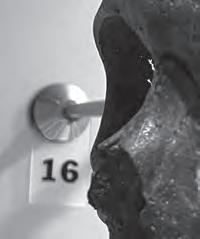
This developing story of museums is one in which they are increasingly speaking to a wider constituency, which can actually contribute and become part of the story. What all of the new cultural institutions on the park have in common is that they are underpinned by a drive to serve a variety of different kinds of public, working in an equitable way with new communities and en gaging them in the sorts of things that concern them, but also offering them opportunities to transform the things that might concern us.
We are working with international and national institutions but our main partners are people living in and around the site. We are trying to forge a place of account and reconciliation that can deal with the difficult stories that museums need to be able to attend to. We’re doing very good work in the four boroughs that surround our sites by working with local groups to find out what they would like to see and how they would like us to engage. We have been doing this years in advance of us opening so that we can get it right, so that they can feel like it is a partnership, rather than something that is landing from another planet which doesn’t reflect the aims, desires and aspi rations of the local community.
Gus Casely-Hayford Direc tor, V&A East.
Museums need to shift to reflect new technologies and the publics’ expec tations, particularly those of young people. This requires new museums that are calibrated to the concerns of a new age. Digital spaces have changed the way in which people feel and interact in most areas of life. Museums are im portant institutions that link opportunity for the young with opportunity for professionals and the academic world, and most importantly create a continuity between all of those different areas. It’s great that a child can come into an environment and share a re search space where sitting next to them might be someone do ing their PhD, and next to them is someone who is redefining a particular sector or industry. I see this crucible of possibilities in bringing together multiple voices, that gives opportunity to the young but also creates a feedback loop in which people who are very established can look at the sorts of revolutionary things that young people are thinking about and innovating.
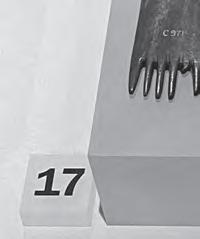
We are trying to forge a place of account and reconciliation that can deal with the difficult stories that museums need to be able to attend to.
Finally, post Brexit it is time for us as a nation to begin to for mulate a new set of relationships, not just nationally, but interna tionally. V&A East has a part to play within that because the arts must be substantive ambassadors for Britain in this moment. This area of East London has a great tradition of creative innovation, it has a huge voice, and it needs to be heard. I hope that the V&A can be a platform, or a megaphone, on their behalf.

PEOPLE PLACE POWER
FROM FINDING SAFE SPACES IN HOSTILE ENVIRONMENTS, TO RE-IMAGINING LIBERATED SPACES
As a nation we are experiencing a myriad of disruptions and challenges, both inside and outside of the cultural sector. Museums and heritage sites are ac tive shapers of their surroundings due to their huge influence on society and the economy. Therefore, here we consider different experi ences within hostile built environments and explore how we might reimagine these spaces as liberated places in the future.1
The lens of psycho-geographies is use ful to examine the importance of identify ing coded messages of hostility and modes of exclusion and alienation. The limitations of the heteronormative patriarchal imagina tion have given rise to various design systems that have historically prioritised the needs and conveniences of able-bodied men over all oth ers. These limitations impact detrimentally on our sense of belonging, and freedom to navigate the built environment. Con cepts such as chromophobia in architecture and white cube museum design — explored by Detoxer, Susuana Amoah — have further robbed us of a sense of being understood in spaces that might authentically represent us.
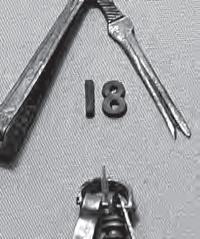
Acknowledging that many heritage buildings and museums memorialise oppression, trauma and wounding for some, and do not just display beauty and artistry as experienced by others, is imperative.
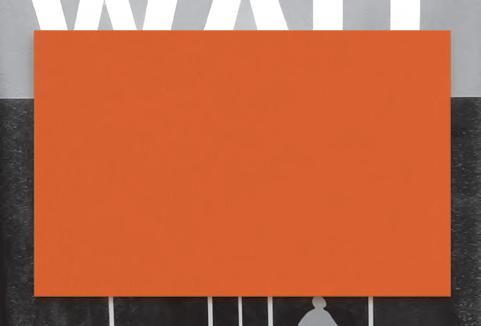
Acknowledging that many heritage buildings and museums memorialise oppression, trauma and wounding for some, and do not just display beauty and artistry as experienced by others, is imperative. This is slowly being recognised through notions of neuro-architecture. In allowing for traumatic memory, it is important to reflect that these are places where our possessions, histories and stories have historically gone to die and be forgotten. In this sense, museums can be seen as mausoleums.
However, we want to bring in some light and healing, to exhale and refocus our energy to create different atmospheres. We can start to look past hostile environments to a future that is different for people of colour in the workforce, in cities and as visitors to cultural and historical places. We need to shift our focus to reimagine what liberated spaces might look and feel like for us.
In order to do this we need to reflect on what safety and belonging feels like in the museum work force, in a city’s cultural landmarks and buildings, and as visitors to these spaces, as well as the differences between our understandings of safety and liberation. We need to talk openly about how barriers to that sense of liberation can be challenged through the reclamation of both spaces and our history, in order
Museum Detox
to oppose that hostility and exclusion in the landscape, workforce and visitor experience. This includes envisioning what liberated spaces might look and feel like, and the signals and codes that might begin to redefine that experience. The work of Museum Detox is powerful because the visual representation of a group of peo ple of colour in cultural spaces challenges perceptions and ideas of liberation in the eye of the beholder.
1 This text is based on a session run by members of Museum Detox’s 2021 Executive Committee; Charlotte Holmes, Curator at the National Trust; Sam Allen, Director and Arts and Heritage Consultant, Creative Art Social Consultancy Ltd; and Laura Hampden, Historic Environment Record Project Officer, Historic England.
Museum Detox is a network for people of colour who work in museums, galler ies, libraries, archives and the heritage sector. We champion fair representation and the inclusion of cultural, intellectual, and creative contributions from our com munities. As a network we work to deconstruct systems of inequality that exist, to enable a sector where the workforce and audience is reflective of the UK’s 21st century population. Our com mitment is further reflected in our core values of Equity, Solidarity, Support, Activism and Empowerment.

If you are a person of co lour, working in the arts and heritage sectors and would like to join our community, please sign up below: www.museumdetox.org/
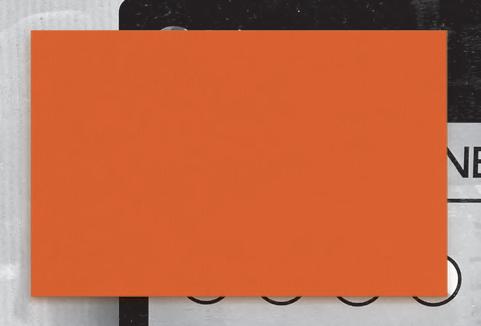
We can start to look past hostile environments to a future that is different for people of colour ... We need to shift our focus to reimagine what liberated spaces might look and feel like for us.
become-a-member

If you would like to col laborate with Museum Detox or make a donation, please contact us below: www.museumdetox.org/ contact-us
You can also follow us on Instagram and Twitter @museum_detox
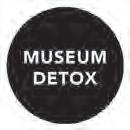
PEOPLE PLACE POWER
Museum Detox members: Hannah Phung.
Larry Achiampong and Megan O'Shea
CRITICAL THINKING FOR PUBLIC SPACE
This text by Megan O'Shea is accompanied by imag es and film stills provided by artist Larry Achiampong and created as part of his role as Artist-in-Residence for the public realm redevelopment of the historic Smithfield area of the City of London, 2021
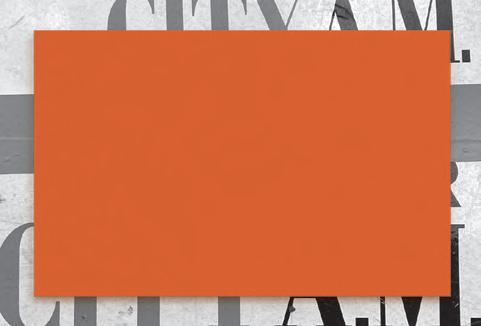
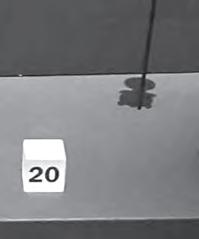
As a child, artist Larry Achiampong occasionally accompanied his mother on cleaning jobs in office blocks, crossing the emptied City of London in the early hours of the morning, experiencing the City in a lull before the workers arrived for the day. These early memories of London — outof-hours, occupied but by those who might go unnoticed — informed Achiampong’s response in his role as Artist-in-Residence on the design team transforming the public spaces around Smithfield. Achiampong was invited into the role of Artist-in-Residence by the City of London and the cultural district Culture Mile in order to inform the design of the area's public spaces ahead of the Museum of London’s move to West Smithfield.1
The project was conceived of before the pandemic, when public space was bustling and lockdown an unheard-of concept. At that time, we discussed what it might mean to be an Artist-in-Residence when there is no residence, but rather an embedded role as part of a collaborative team of designers working on a public space. In reality, Achiampong’s residency occurred during a period when public space was closed to most publics, and collaboration with the design team was forced online. This became a residency based on memories of place and feeling, rather than site visits and physical mapping.
A residency based on memories of place and feeling, rather than site visits and physical mapping.
The residency centred around a series of online workshops structured by Achiampong, and his collaborator Nephertiti Oboshie Schan dorf, 2 with materials including film, music and text shared to invite responses to the themes: Texture; Memory and Place; Light, Memory and Time. Some of these references are shared on these pages, alongside a selection of stills from the film Achiampong made in St Bartholomew's Hospital in West Smithfield during the residen cy. The staff of this hospital, among the few who continued to traverse the City through the pan demic, in the dawn and dusk hours, retraced, for Achiampong, the footsteps of his childhood. Because the residency did not coincide with an intensive design period, there was no pressure on the design team to deliver immediate outcomes. Instead, this strange pandemic time — when every thing seemed at once to be in hiatus and yet more intense — allowed for expansive thinking about place and what it means to different people at dif ferent times. Reflections on the shared materials became personal, with memories and emotional responses entering first the public format of the workshop, and later becoming formalised within the transformation of the Smithfield public realm.
Details of postcards, part of Culture Mile resident consultation on memory and place, designed by Gabrielle Smith as part of Larry Achiampong's Smithfield public realm commission with the City of London, Hawkins\Brown and Contemporary Art Society.
Collage of film stills from Blacks Britannica, Dir. David Koff, 1979. The film was part of the Larry Aichaimpong's Artist in Residence reading list that informed the workshops with the Smithfield public realm commission with the City of London, Hawkins\Brown and Contemporary Art Society.
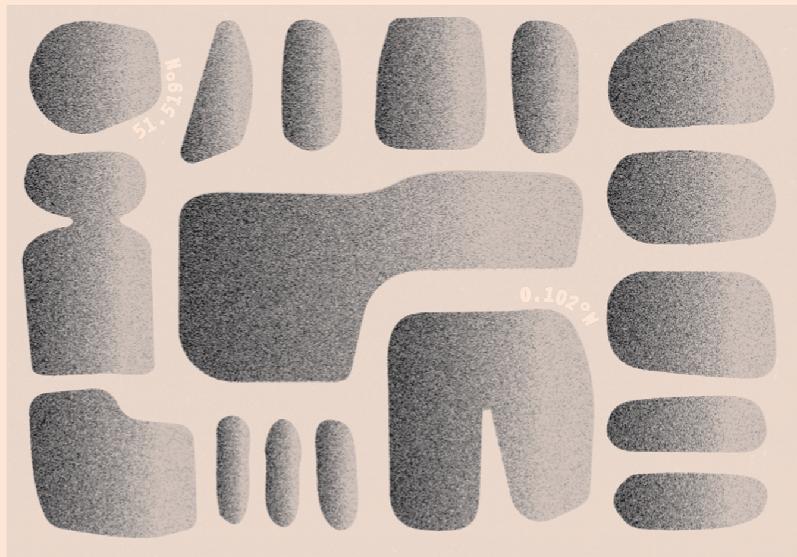

1 Larry Achiampong was chosen following a curatorial process led by Contempo rary Art Society Consultancy. The role was defined through conversations with architects Hawkins\Brown, the City of London and Culture Mile stakeholders including the Barbican and Museum of London.

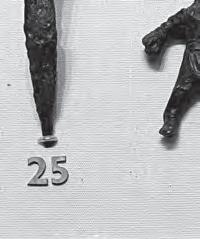
2 The workshops were held online with the Hawkins\ Brown-led design team including Contemporary Art Society Consultancy, landscape architects OKRA, lighting designers Studio Dekka and transport consul tant Momentum.
Text by Megan O’Shea, Se nior Art Producer, Contempo rary Art Society Consultancy.

And so, as we discussed the sounds and rhythms of Smithfield, a conversa tion about crackles in the music of Burial was translated into design thinking about textures for the material palette of these public spaces. The work shops, and the design thinking they prompted, developed iteratively. This process of working with the design team was just the beginning of a series of conversations which have been continued through en gagement with community elders, and will be extended further through a cohort of youth voices. Even when empty, the spaces of Smithfield are continuously filled with overlap ping narratives, and this process has encouraged long-term thinking — about the histories and futures of the site — rather than seeing the design team involve ment with this public realm as ‘a moment’ in time.
The staff of this hospital, among the few who continued to traverse the City through the pandemic, in the dawn and dusk hours, retraced, for Achiampong, the footsteps of his childhood.
Achiampong’s work as Artist-in-Residence, as part of the de sign team and alongside wider Smithfield audiences, shows the benefit of engaging subjectively with the public realm. The resi dency encouraged the interdisciplinary design team to speak their own minds, to share their different personal stories and to design these into the new public spaces. Perhaps, equitable public realm might start here; with a design team sharing its differing and per sonal experiences of space, inviting others to be part of the con versation, and writing-in change through design.
PEOPLE PLACE POWER


 Film stills from 06:30, 2021, commissioned by City of London: © Larry Achiampong. All rights reserved, DACS/Artimage 2021. Courtesy of the Artist and Copperfield London.
Film stills from 06:30, 2021, commissioned by City of London: © Larry Achiampong. All rights reserved, DACS/Artimage 2021. Courtesy of the Artist and Copperfield London.
 Stephen Pritchard
Stephen Pritchard
WATCHING XANADU
A vision in a dream — a fragment. Walls imposed on nature by stately decree. Enclosed palace of pleasure which sees itself reflected in an unrestrained river. Empire. Human power. Nature’s power. Time unending. Time becomes a loop. The loop becomes a song about self-obsession and loss. This song of loss is part of who we are and what we humans do: we build to destroy — keeping little fragments, not to remember the loss we created, but to retell its stories in palatable ways.
The world is on a knife edge. The ‘free markets’ and ‘austerity’ of neoliberal capitalism have led to constant precarity for more and more people, including artists, arts workers, and many arts institutions.

We build our pleasure domes — our mu seums and galleries, our glass castles and concrete cathedrals of cultural power — in our own image, without thought or care for those already there: those whose stories, memories, lives are not worthy of our new faux-Brutalist pleasure domes. Our pleasure domes are for the emperors of our time — and for their followers (and for the emperors and followers of all the empires before and after). For us, not them
We build our walls to protect our vision in a dream — our intentionally fragmented histories and imagery safely preserved as formal, interpreted, collected floral displays behind walled gardens. But no matter how much ‘outreach’ and ‘engagement’ emanates from our pleasure domes, and no matter how much zeal our cultural missionar ies and mercenaries apply, the new emperors do not want the weeds or the supposedly culturally bereft neo-barbarians inside.
No community centres, libraries, youth clubs, sports clubs, playing fields or parks for them. But there is, for example, a place in our pleasure domes — our Xanadus — for fragments of paraded ‘streets in the sky’ — for robbed sections of Robin Hood Gardens council homes — for us.

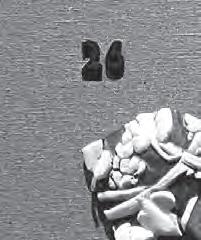 Still from the film A Cacophony of Crows, directed by Stephen Pritchard, 2018.
Still from the film A Cacophony of Crows, directed by Stephen Pritchard, 2018.
But now is a time for everyday utopias, not just gilded cultural pleasure domes. Everyday utopias can re-enchant our everyday lives by understanding that we all have visions and dreams.
The re-enchantment of our everyday lives is not about museums and galleries leading the way to some culturally rich promised land in which our pasts and presents are censored, sanitised, sugar-coated then mercilessly monetised. This is the path to disenfranchisement and disenchantment. Instead, re-enchantment puts people before place and power, cultural democracies ahead of bureaucracies, to create beauti ful everyday utopias in which our pasts, presents, futures are shared and celebrated.
The world is on a knife edge. The ‘free markets’ and ‘austerity’ of neoliberal capitalism have led to constant precarity for more and more people, includ ing artists, arts workers, and many arts institutions. This sys tem treats nature and people as ‘things’ to be stolen, bought, sold, fought over. It turns some artists into individual heroes and celebrities but many others into freelancers battling for commissions that are increasingly unlikely to support reasonable standards of living. It turns arts institutions into enterprises, arts workers into expendable casual workers, and audiences and community members into ‘targets’. But this is something that can be changed, slowly. It will be a struggle in which our best action is the re-enchantment of art, of cultures and of our everyday lives. We need realisable alternatives, and we need to focus on developing them and trying them out now. It is not enough to believe, to hope — we must listen, enact

Just because we’re part of the system it doesn’t mean we can’t change the system from the outside from the borders , margins, peripheries, and edges – and from the inside from within the institutions of art, the businesses, the focus groups, the state agencies.

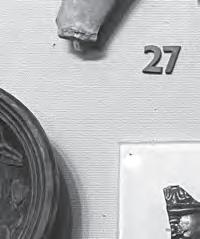
PEOPLE PLACE POWER
Still from the film A Cacophony of Crows, directed by Stephen Pritchard, 2018.
hope, and embody trust; remember our pasts and imagine our futures – good, bad, different, differently; self-organise. Self-organising is not about selfish ness but about collectiveness: cooperation, not cut-throat competition.

And, as artists, cultural workers, creative industries managers, museum administrators, we are part of the system. But just because we’re part of the system it doesn’t mean we can’t change the system from the outside — from the borders, margins, peripheries, and edges — and from the inside — from within the institutions of art, the businesses, the focus groups, the state agencies, etc. Our ability to make such changes lies in our abilities to selforganise and produce new alternatives.
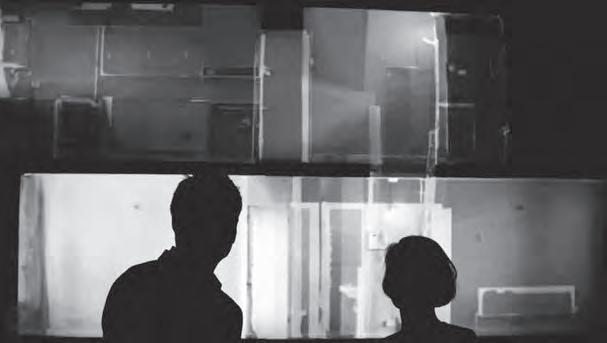

Our little acts of re-enchantment are about rediscovering what it means to be human and about how deeply we are connected to one another and to nature.
For example, many cultural organisations and museums may ‘perform’ social justice and community care, but they can also embody compassion and embrace their communities
— with our help. No amount of state aid or co ercion can achieve this. But, by self-organising for change, we can all help to Do It Together.
A re-enchanted culture of all our cultures — all our pasts, presents and futures — can help us unlearn our deeply engrained capi talist narratives. It requires new forms of cultural production — sharing, not competition: reconnection with one another and with nature. Our little acts of re-enchantment are about rediscovering what it means to be human and about how deeply we are connected to one another and to nature.
We need to escape our Xanadus — sing our Songs of Innocence and Experience — because, paraphrasing William Blake, when we see the world in every grain of sand and heaven in every wildflower, we can leave our shackles behind and begin to become truly human again.
Watching Xanadu
Stephen Pritchard Arts professional and indepen dent academic.
Still from the film A C acophony of Crows, directed by Stephen Pritchard, 2018.
MUSEO DE LA SOLIDARIDAD SALVADOR ALLENDE: A MUSEUM PERMEATED BY ITS SURROUNDINGS
Above: Press record of the first inauguration of the Museum of Solidarity. Salvador Allende and Mário Pedrosa appear among those attending the exhibition in front of the sculpture by Octavio Podestá ‘Gong’ 1971 . Santiago, Chile: MSSA archive, May 1972 . Below: Press record of the publicity of the first exhibition of the Museum of Solidarity in 1972 titled ‘The Nation’. Santiago, Chile: MSSA archive, July 2 1972 .

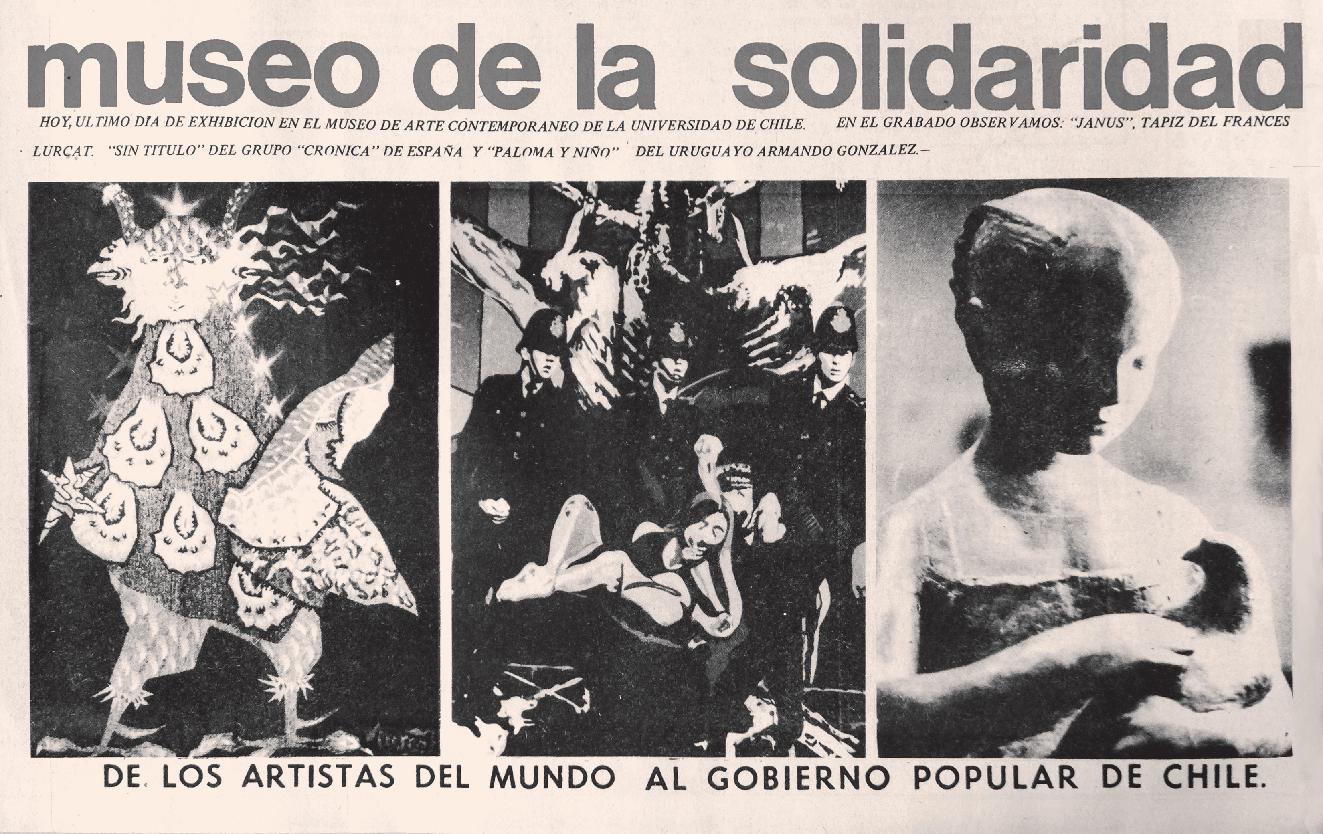
The Museo de la Solidaridad Salvador Allende (MSSA, Salvador Allende Museum of Solidarity, in English), is a modern and contemporary art museum in Santiago de Chile. It is home to an art collection of high international value, one of the most important in Latin America. The museum is considered a referent for its curatorial model, which defies hegemonic principles in the field of arts and culture. Its collection was formed through artists’ solidarity outside the mainstream art market, and thought through the lens of critical curatorial practices.
The museum was founded in 1971, when the idea of encouraging artists’ circles across Latin America and Europe to donate artworks emerged. The aim of these donations was to enable Salvador Allende’s gov ernment — the first democratically elected socialist government in the world — to create a museum ‘for the Chilean people’.
The ideological tensions that Chile and the world have faced since its creation have had an impact on the museum, which has been known by three different names since it was founded: → Museo de la Solidaridad (1971—1973). A period of international artists’ donations to the people of Chile.
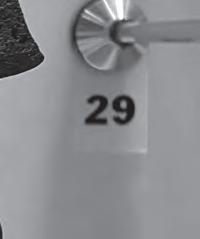 Claudia Zaldívar
Claudia Zaldívar
→ Museo Internacional de la Resistencia Salvador Allende (1975—1990). Following the coup of 1973, the project was taken into exile and artists’ donations became political gestures of resistance against dictatorship.
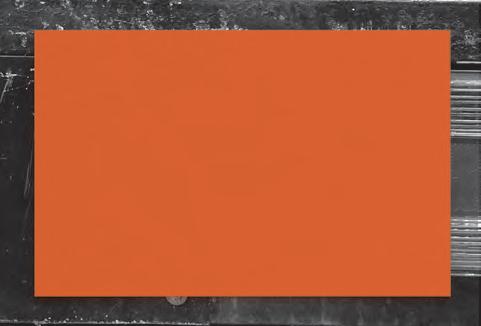
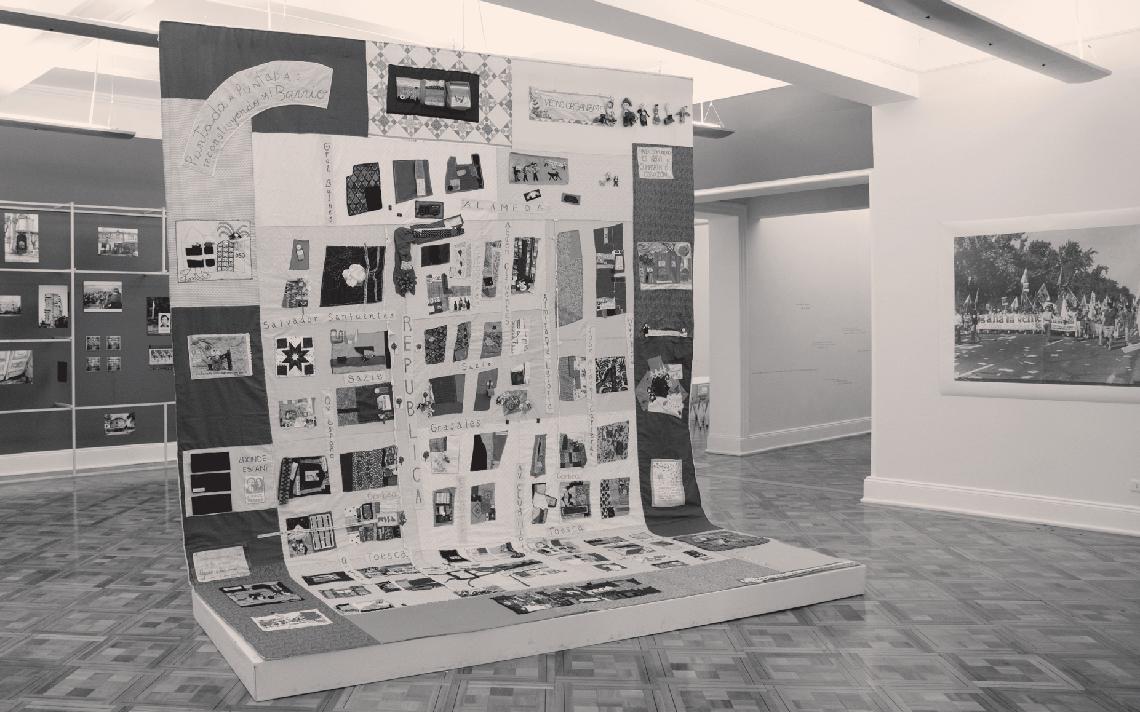
→ Museo de la Solidaridad Salvador Allende (1991—present). Since the return of democratic elections, artworks that had been kept abroad have been brought back to Chile and reunited with parts of the collection that had been hidden since the 1970s. It is a collection that keeps growing to this date.
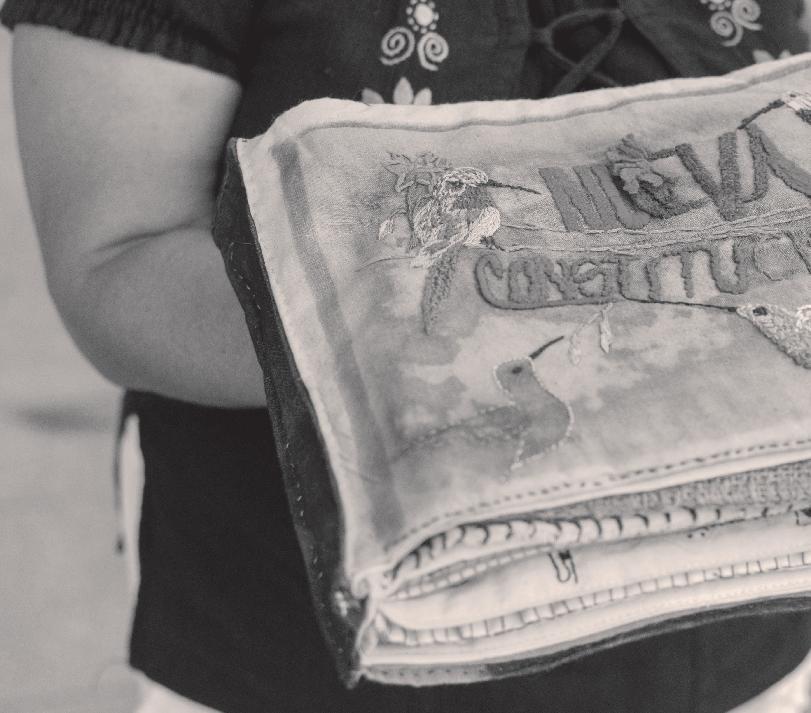
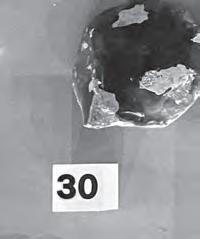
The MSSA situates itself as a live, open, permeable space. As a dynamic platform in permanent transformation and dialogue, the museum facilitates process and experience.
The museum’s curatorial model was developed by a global network of progressive artists and intellectuals. Brazilian art critic Mário Pedrosa, the founder and first director of the museum, understood art as ‘an experimental exercise of freedom’. Pedrosa argued that art projects that incrementally integrated art in daily life, that connected interior with exterior, and that responded to the social function of educating citizens’ sensibilities, allowing them to discover new ways of relating to the world, should be incentivised. The museum was therefore con ceived of as a progressive and experimental space of experiences — a paralaboratory both for artists and the wider community.
With these foundational principles that are so fundamental to our current social reality, the MSSA situates itself as a live, open, permeable space. As a dynamic platform in permanent transformation and dialogue, the museum facilitates process and experience.
Since 2012, when I became Director of the MSSA, our work has taken a critical pedagogical and curatorial standpoint, based in principles of cultural
Museo de la Solidaridad Salvador Allende
Textile Registry created by the residents of Barrio Republica exhibited in the Mirada de Barrio Exhibition. Santiago, Chile: Lorna Remmele, MSSA archive, 2019
The textile book New Constitution created by the MSSA Textile Companies. Santiago, Chile: Lorna Remmele, MSSA archive, 2020
and artistic mediation, enhancing dialogue, experimentation, and individual reflection from the collective. In 2016 we started the transdisciplinary project Mirada de Barrio (Neighbourhood Gaze), which saw sociologists and artists collaborating with the museum team. Following several encounters to build trust with local neighbours, a decision was made to start work on an exhibi tion on the neighbourhood’s past, present and future heritage. The exhibition showcased creations that emerged from a co-creative process of textile, photography, writing and book binding work shops. Titled Haciendo Barrio (Making Neighbourhood), the exhibition opened in September 2018. It was a product of collective curation with a group of neighbourhood representa tives of the different workshops. The complexity of this project meant that it was an important learning process which has transformed the museum as an institution, and its staff. The project has opened new relationships of trust with the museum’s local community. By setting ourselves up as a permeable institution, with all the risks that entails, we have become another member of the local community. The community/institution relationship has always been a complex and asymmetric one, and it is common that the former is suspicious of the latter. Collaboration has been built bit by bit among neighbours, local organisations, the museum and its staff. This process has prioritised respecting diversity and each party’s own dynamics, all the while establishing a day-to-day dialogue through which the common project is in permanent negotia


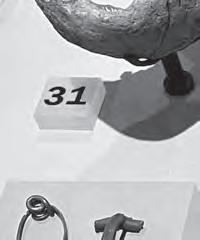
By setting ourselves up as a permeable institution, with all the risks that entails, we have become another member of the local community.
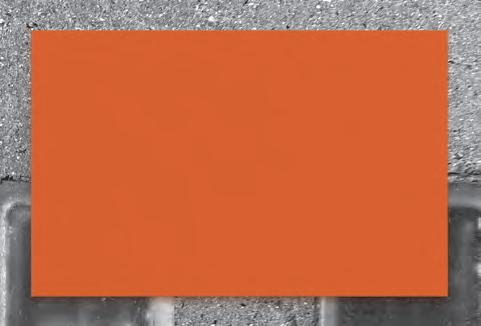
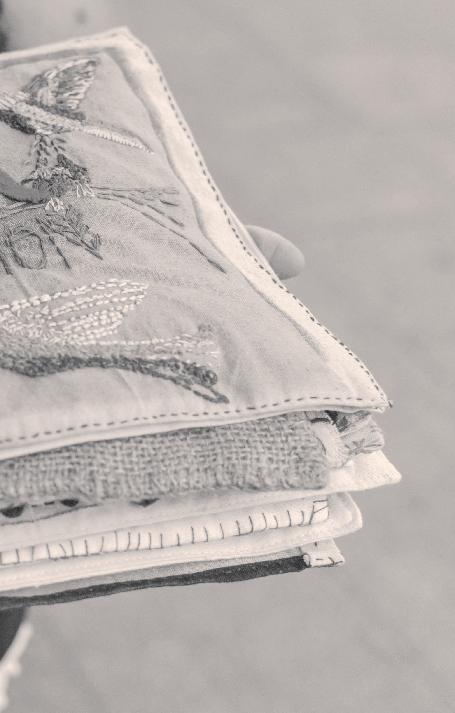
PEOPLE PLACE POWER
Activity called ‘Making with hands’ during the program Linking with the Territory. Santiago, Chile: Lorna Remmele, MSSA archive. November, 2019
tion and discussion. Publics are propositional, heterogenous and in constant transformation. Everyone brings their own subjectivities and personal his tory, adding tension to the shared space, to the museum, and therefore to its public. The root of such tension is an understanding of the museum’s link to its surroundings as the cornerstone of our museum policy, based in solidarity, political and artistic principles. The museum, with an institutional structure, responds to that tension by rethinking itself.
We are convinced that the current fracture in the country’s social fabric must be rebuilt from affection, from the local, and alongside communities.
The 2019 social outburst in Chile strength ened the MSSA’s links with its local community. While most museums responded to street protest by closing their doors, we made the museum available to our community. This was the starting point of a busy schedule of citizens’ encounters attended by hundreds of people. In parallel to the growth in citizen reflection, a path to reform the country’s constitution, created during the dictatorship, was established. One year later, amid the COVID-19 pandemic, 80% of citizens voted in favour of a new constitution for Chile.
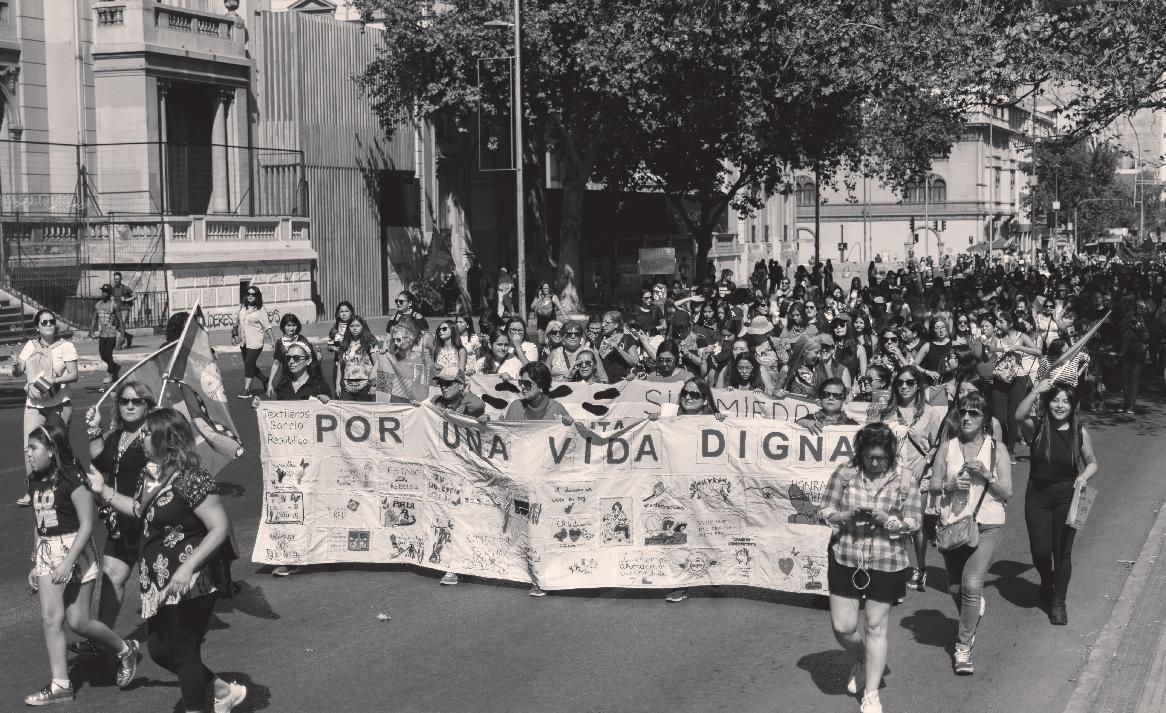
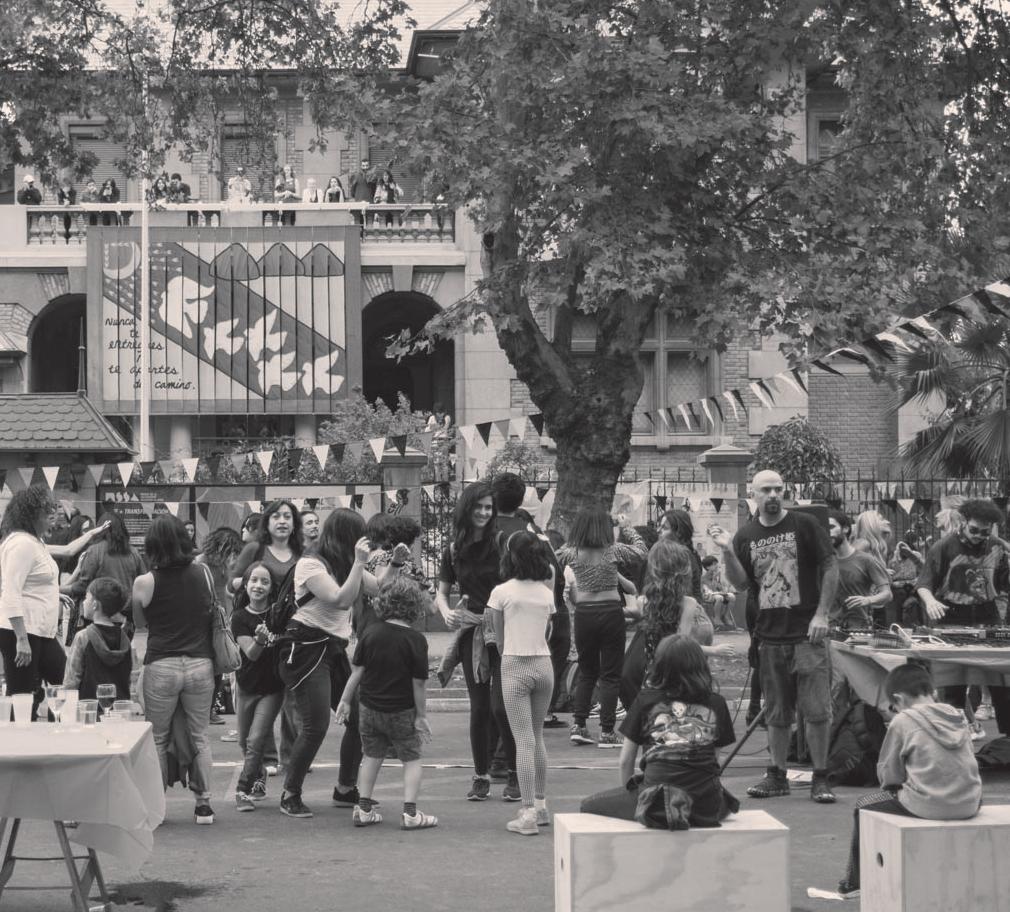
We believe that the current fracture in the country’s social fabric must be rebuilt from affection, from the local, and alongside communities. We are committed to being a platform that facilitates pro cesses, that is permeable and open to collaboration, and is a space that expresses horizontal manage ment based in trust, honesty and listening to each other. Our aim is to move towards the integration of the arts within daily life, a vision that permeates the museum as a critical space created in solidarity and fraternity — a Latin American beacon of arts and politics.
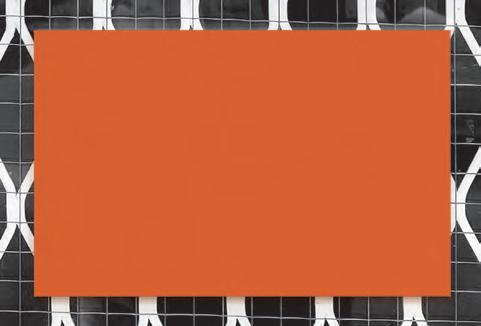
 Museo de la Solidaridad Salvador Allende
Claudia Zaldívar Director, Museo de la Solidaridad Salvador Allende.
Participation of the Museo de la Solidaridad Salvador Allende in the Interna tional Women's Day march. Santiago, Chile: Lorna Remmele, MSSA archive, March 8th 2020
Inauguration of the Tejido Social Exhibition. Museum of Solidarity. Santiago, Chile: Lorna Remmele, MSSA archive, April 30th 2019
Pedro Fiori Arantes
Museo de la Solidaridad Salvador Allende
Claudia Zaldívar Director, Museo de la Solidaridad Salvador Allende.
Participation of the Museo de la Solidaridad Salvador Allende in the Interna tional Women's Day march. Santiago, Chile: Lorna Remmele, MSSA archive, March 8th 2020
Inauguration of the Tejido Social Exhibition. Museum of Solidarity. Santiago, Chile: Lorna Remmele, MSSA archive, April 30th 2019
Pedro Fiori Arantes


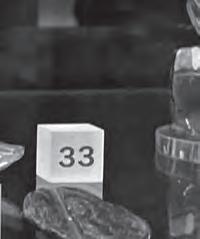
WESTERN FANTASY AND TROPICAL NIGHTMARE: SPECTACULAR ARCHITECTURE, NEW MUSEUMS AND URBAN WARFARE IN RIO
Rio de Janeiro is a paradigm of contradictions produced by the violence of the competitive management of cities and the extreme architectural and ur ban forms built for mega-events and large real estate projects. In Rio — host of the 2014 World Cup and the 2016 Summer Olympics — arenas, Olympic constructions, luxury buildings, new museums and cultural centres designed by ‘starchitects’ are framed by a paradisiacal backdrop that renews colonial dreams of the Western tropical landscape.
Arenas, Olympic constructions, luxury buildings, new museums and cultural centres designed by ‘starchitects’ are framed by a paradisiacal backdrop that renews colonial dreams of the Western tropical landscape.
In a Benjaminian sense, the architectural forms and extreme geogra phies of Rio that I will present here, act as revealing ‘allegories’, and their ‘regimes of visibility’ as ‘allegories of capitalism that have the duty to take the market-form to its ultimate consequences’.1 Rio is a place where Benjamin’s definition of ‘the Golden Age as catastrophe’ 2 is remarkably evident. But Rio, unlike Paris and its Arcades, is a city of stunning open-air scenery which mobilises the European exotic fantasy of the tropical paradise on earth, fuelled by the narratives and paintings of travellers. We must not forget that 19 th century Rio was still the largest modern city in the world to practice slavery extensively.

Prev. page (below): The Dinner. A white couple being served and fanned by black slaves. 19th century Rio was the largest modern city in the world to prac tice slavery extensively: Jean-Baptiste Debret, 1837. Itaú Cultural Collection. (Public Domain).
Above: Guggenheim Project (not built), Pier Mauá, Rio, 2002—2008: Atelier Jean Nouvel. © AJN
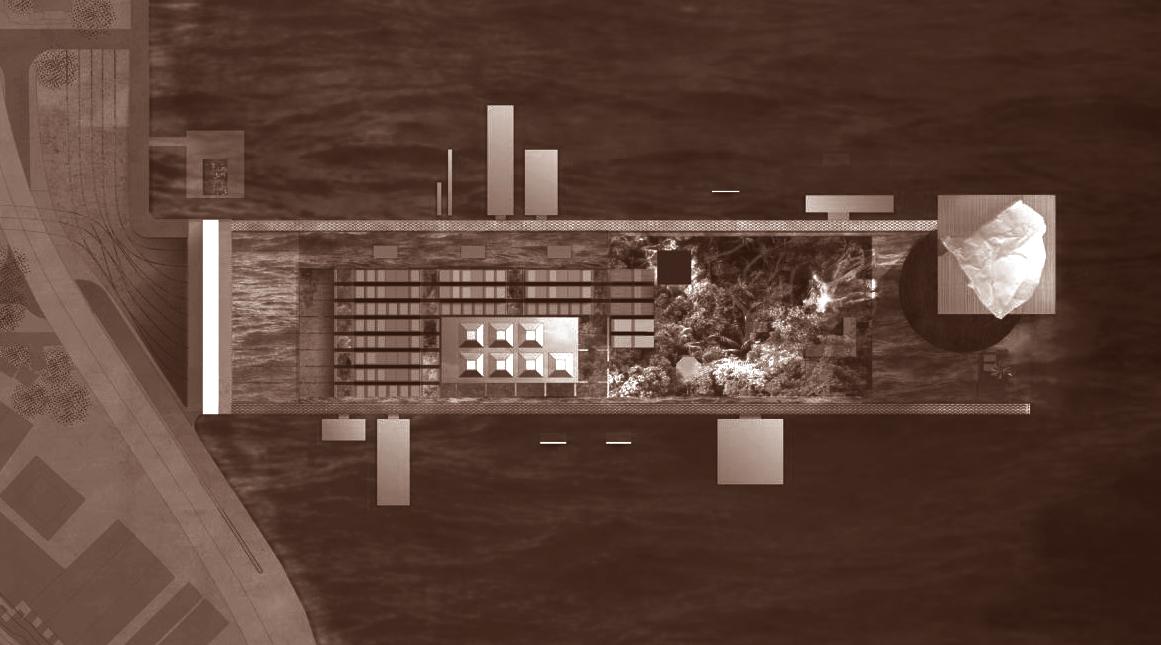

The ‘economics of appearances’ of mega-events and cultural sets presupposes ‘pacification and depoliticization’, in the words of Jules Boykoff, a ‘festive commercialism with military fortressification’.

One of the most fabulous (in the sense of a fabled) projects in 21st century Brazil, although unbuilt, was that of the Guggenheim Rio, designed by architect Jean Nouvel who was commissioned in 2002 by Thomas Krens. It was to serve as the ‘anchor’ of Rio’s waterfront renovation strategy, which would be named — with a fantastical marketing name — Porto Maravilha (Wonderous Harbor). The French architect, as an ‘urban imagineer’ (in the words of Sharon Zukin),3 reproduced a tropical ‘theme park museum’. In a presen tation about the project the architect stated, without any hesitation, that he had conceived of ‘dream territories’ and that he was inspired by the ‘myth of Atlantis’.4
1 T. Clark, ‘Should Benjamin Have Read Marx ?’. Boundary
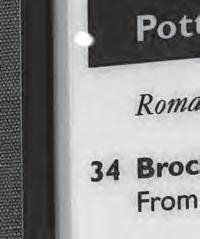
2. 30:1, 2003, pp. 31–49
2 B. Walter, The Arcades Project. Harvard University Press. Translated by Howard Eiland and Kevin McLaughlin. 1999, p.906.
3 S. Zukin, The Culture of the Cities. Oxford, Blackwell. 1995.
4 J. Nouvel, A Submerged Port 2002. http://www. jeannouvel.com/en/projects/ musee-guggenheim/
The same pier that had been offered up for the Guggenheim became host to a new project several years later — the Museum of Tomorrow — designed by Santiago Calatrava. The Museum of Tomorrow is not a typical science museum. It is about the Anthropocene, environmental imbalances and a desirable sustainable future. However, the Anthropocene’s in teractive spectacularisation on display is completely sanitised, with an expography based on media, games, and data with
The Museum of Tomorrow, Pier Mauá, Guanabara Bay, 2010—15: © Calatrava.
Prev. page (above): Rio’s Botafogo Bay and Princess Joaquina Mansion — a stunning open-air scenery, which mobilizes the European fantasy: Johann Moritz Rugendas, 1820. Brasiliana Collection. (Public Domain).
Western Fantasy and Tropical Nightmare
little critical reflection. The contradictions, conflicts, massacres and predations produced by the unbridled expansion of capital are trans formed into a show of ascetic and technological images.
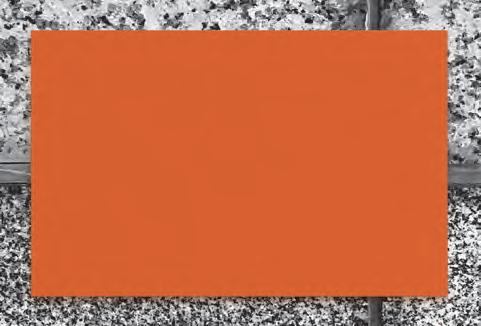

The traumatic remembrance of experiences by a community strengthens their resistance against new forms of submission that may happen.
5 J. Boykoff, Celebration Capitalism and the Olympic Games. London: Routledge. 2014, p.18
6 J. Boykoff, Celebration Capitalism and the Olympic Games. London: Routledge. 2014, p.109.
The museum anchored in Guanabara Bay does not hide the violence of its colonial presence of conquest. It is like a ship docking at the pier, un loading a vision of the future into the city in the form of an eco-technical and Eurocentric envi ronmental discourse, without regard for other epistemologies, vi sions and cultures (in which Brazil is rich and plural). Needless to say, a large amount of the public resources for these new private museums ended up far from Rio’s public institutions, which suffer from underfunding.
Urban renewal in Rio is anchored in new cultural or Olympic facilities with spectacular architecture. The ‘economics of appearances’ of mega-events and cultural sets presupposes ‘pacification and depoliticization’, in the words of Jules Boykoff,5 a ‘festive commercialism with military fortressification’. 6 Rio was the first place in the Global South to host the Olympic Games, with all the

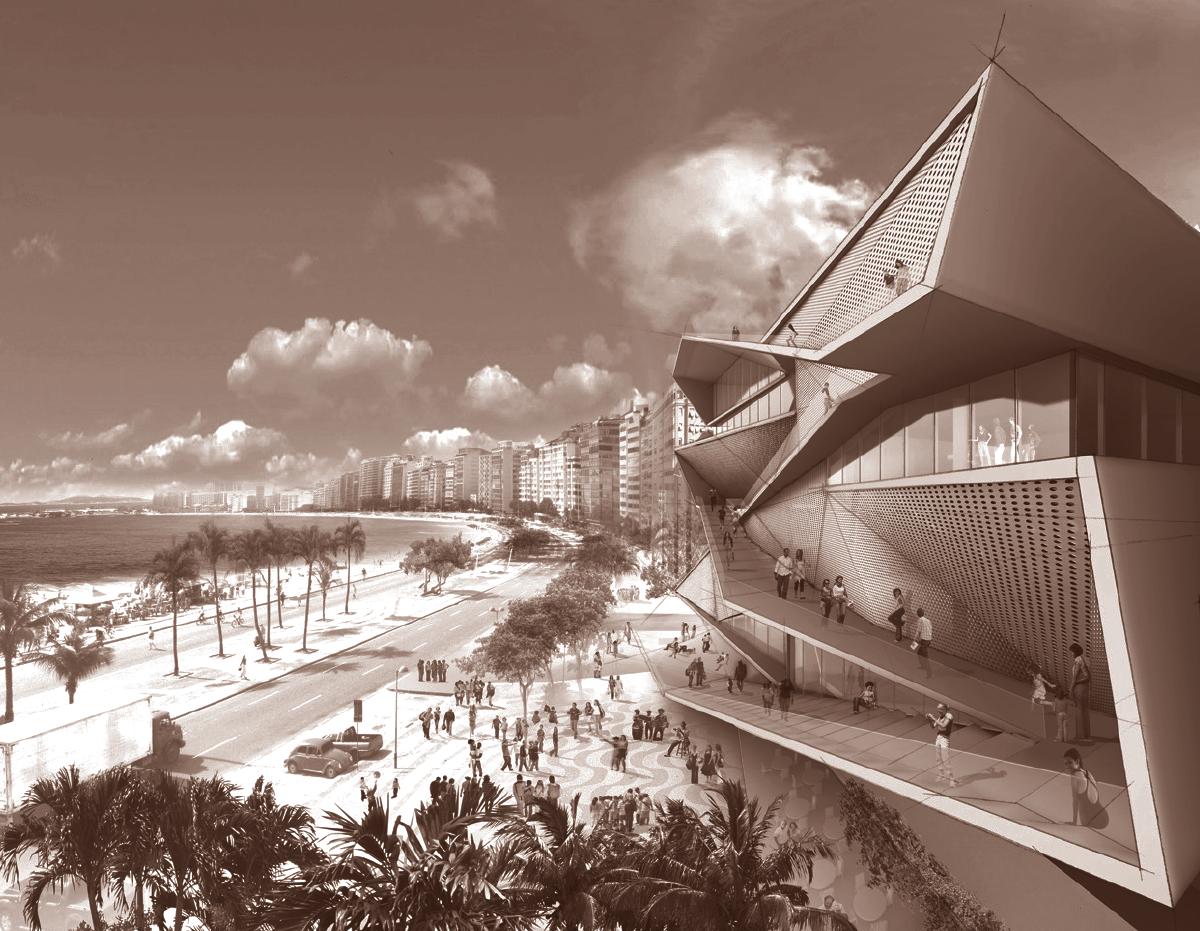 Museum of Image and Sound (under construction), Copacabana, Rio, 2009—present: © DS + R
Museum of Image and Sound (under construction), Copacabana, Rio, 2009—present: © DS + R
PEOPLE PLACE POWER
As an anti-Museum of Tomorrow, it is a space where the absence of form reveals the presence of a struggle, remembering inequalities that have accompanied Brazilian history for centuries.
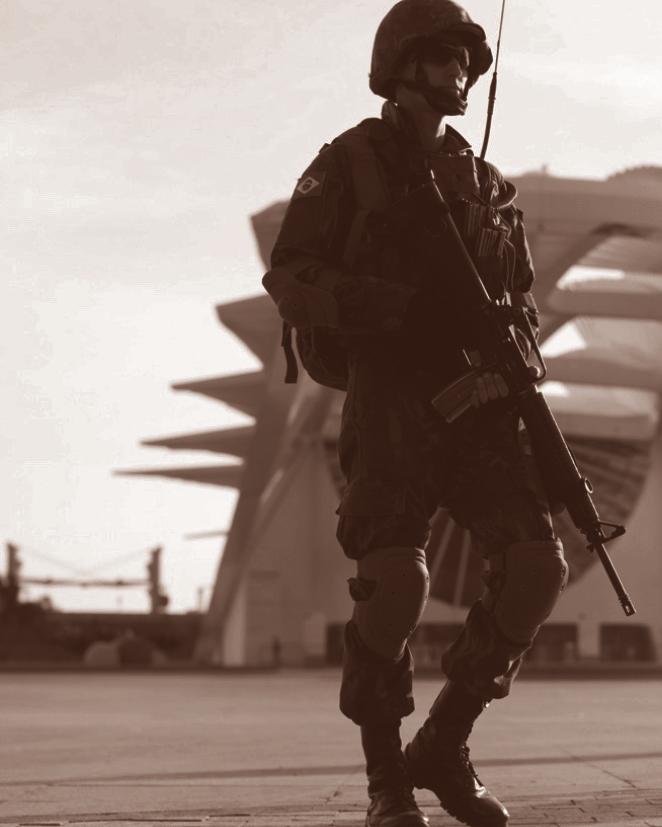
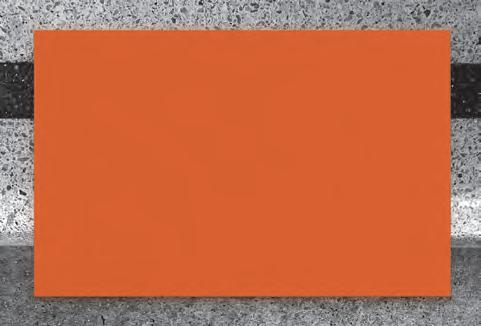
dramatic symbolism of an experiment rooted profoundly in the system of exception imposed by a mega-event, and in which ‘celebration capitalism’ is simultaneously, to use the words of Naomi Klein, ‘disaster capital ism’.7 On the western border of the colourful and festive Olympic Park, however, the nightmare of the Black and poor people who lived in the region was playing out as Vila Autódromo (Racetrack Village), originally a fishing colony, was partially evicted. The Olympic specula tive wave renewed the nightmare of removals, with an estimated 67,000 people removed from across Rio during this era of mega events.
Nightmares can be warnings The traumatic remembrance of experiences by a com munity strengthens their resistance against new forms of submission that may happen. The countless projects and interventions, the destruction of neighbourhoods, the attacks on rights, and the many instances of social counter-reforms that occurred in the decade that these mega-events took place rep resent a kind of urban shock doctrine that, at first glance, paralyses the horizon of social movements that fight for a future of urban and social justice.
But resistances do exist. For example, in Vila Au tódromo, popular organising guaranteed the continuing memory of the community by converting the
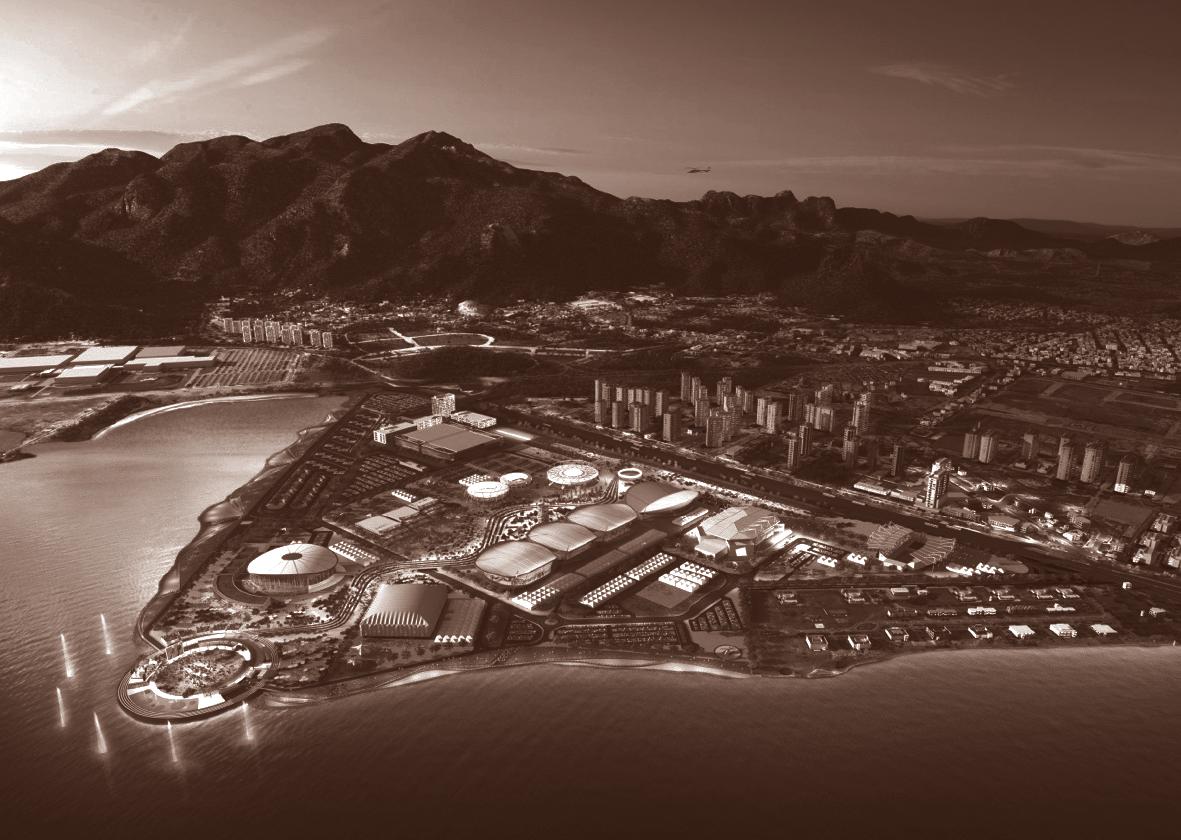

Western Fantasy and Tropical Nightmare
Original design of the Olympic Park, 2011—2015: Architect – Bill Hanway (AECOM) © AECOM
The military performing urban security during the 2016 Olympic Games: Márcia Foletto. © Foletto.
7 N. Klein, The Shock Doc trine. The Rise of Disaster Capitalism. London: Penguin Books, 2008
8 A. Huyssen, Present Pasts: Urban Palimpsests and the Politics of Memory. Stanford: Stanford University Press, 2003, p.18
9 A. Huyssen, Present Pasts: Urban Palimpsests and the Politics of Memory. Stanford: Stanford University Press, 2003
Pedro Fiori Arantes Associ ate Professor, Federal Univer sity of São Paulo.
demolished area into a Museum of Evictions. As an anti-Museum of Tomorrow, it is a space where the absence of form reveals the presence of a strug gle, remembering inequalities that have accompanied Brazilian history for centuries. A museum of the ruins of forced displace ment has special meaning when the future does not look promising for the vast majority of the population As Benjamin claimed, the ruins indicate the trail of catastrophe left by progress. Or, in the terms of Andreas Huyssen: ‘Why are we building museums as if there were no tomorrow?’.8
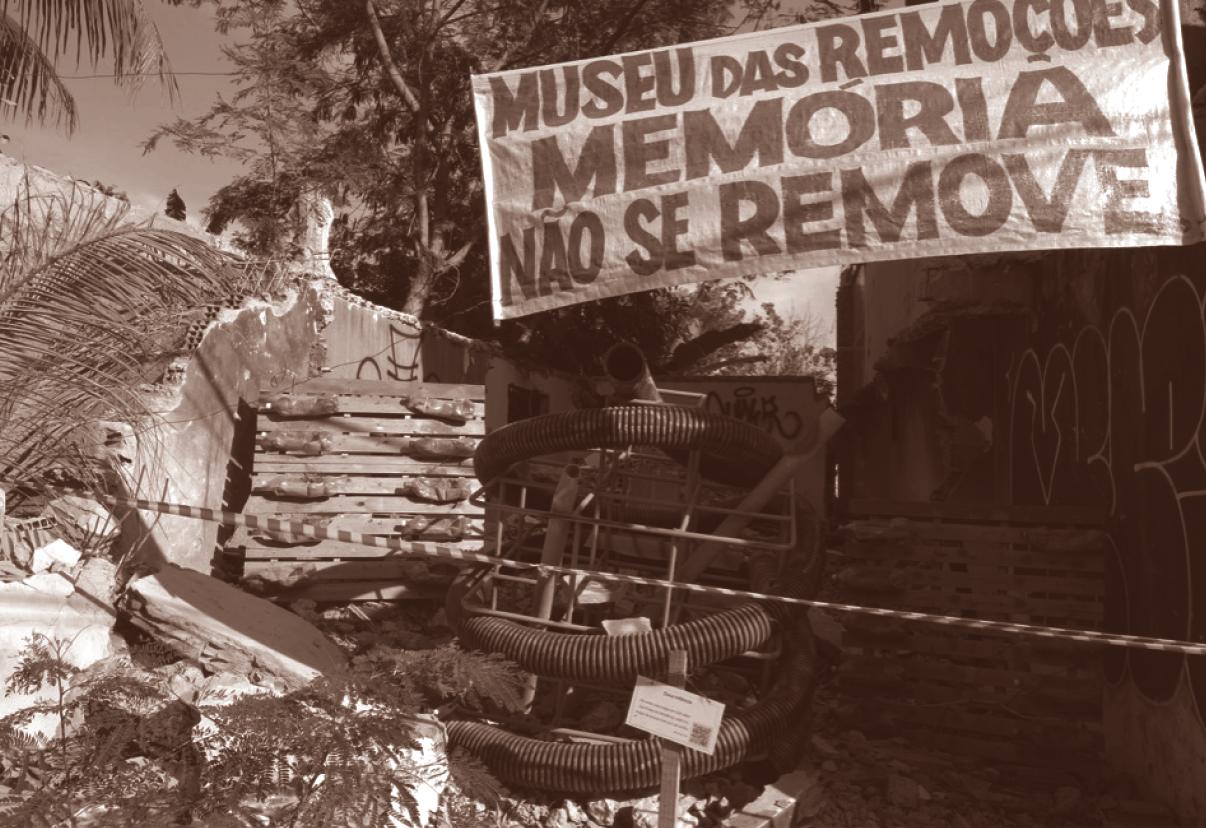
They show another possibility for the politics of memory, a rupture that brings ‘uncomfortable places’ into evidence so that tomorrow may not be one of ‘selective forgetting’.

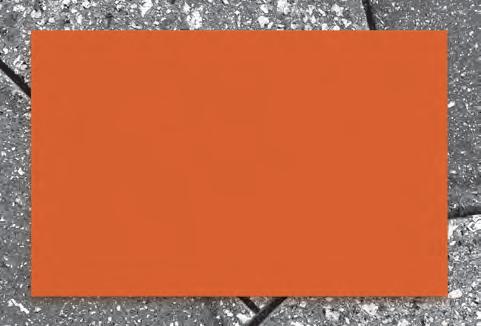
In Rio, there was an attempt to transform tomorrow into a memory of seduction celebrating the urban experience as a theme park for the happy few. But the landscapes of resistance bear witness to the politics of the displaced and dispossessed. They show another possibility for the politics of memory, a rupture that brings ‘uncomfortable places’ into evidence so that tomorrow may not be one of ‘selective forgetting’.9
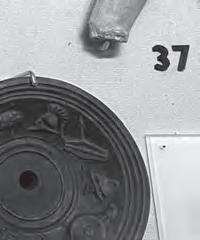 Open air Museum of Evictions. The banner reads – Memory cannot be evicted: © RioOnWatch/Catalytic Communities.
Open air Museum of Evictions. The banner reads – Memory cannot be evicted: © RioOnWatch/Catalytic Communities.
PEOPLE PLACE POWER
MUSEU DA MARÉ: MUSEOLOGY FROM THE FAVELA
The Maré Center for Solidarity Studies and Action, created in 2006, was born from the struggles of local residents in the Maré favela, in northern Rio de Janeiro. Over the years and through cooperation and knowledge exchange between diverse people and institutions this space has become an important cultural reference for the city of Rio. It is a space that is open to the local com munity, for social movements, and for collec tives from across Rio.
The Maré favela is located in the North Zone of Rio de Janeiro and comprises a cluster of 17 communities, where about 140,000 people live. The region borders the Guanabara Bay and is located between major highways that cross the city. In 1997 a group of Maré residents came together to create the non-governmental organisation Centro de Estudos e Ações Solidárias da Maré (Maré Center for Solidarity Studies and Action), the institution that manages the museum.
The central exhibition held by the museum — The Times of Maré (Os Tempos da Maré) — is a collection that resulted from research carried out in the city’s public archives along with donations made by residents who con tributed personal objects and testimonials of their life stories. In the exhibi tion everything is mutable as past, present and future co-exist. The exhibit is organised around 12 archetypal themes that speak to the historical development of the Maré communities and realities of everyday lives. Visitors are welcomed into the exhibition by a large orange display that references the colours of the earth and clay in the arid and dry regions in northeast Brazil, the place of origin of the first residents of Maré.
Visitors are welcomed into the exhibition by a large orange display that references the colours of the earth and clay in the arid and dry regions in northeast Brazil, the place of origin of the first residents of Maré.
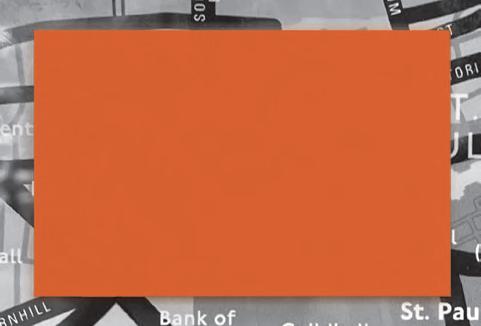
The exhibition begins with the transfor mations that have occurred in the Bay since the 1920s, and the impact on the environment caused by the major works carried out by the public authorities including: construction of the Avenida Brasil (1946); landfills that integrat ed eight islands, creating the Island of Fundão, housing the Federal University of Rio de Janeiro (1953); installation of the Manguinhos Oil Refinery (1954); and finally the Rio Project, which filled in parts of the Guanabara Bay and created new communities in the region of Maré (1980). This section is called Times of Water and is saturated with different shades of blue that allude to the colours of the Guanabara Bay.
Next, we pay tribute to the north-eastern people (or norderstinos) who, from the 1940s onwards, mi grated to Rio de Janeiro in order to work on these large construction projects. Included here are

Cláudia Rose Ribeiro da Silva
bottles, of different shapes and sizes, which contain pieces of the land from the hometowns of the first north-easterners who arrived at Maré. We always invite visitors to donate soil of their own hometowns to add to this display.
Further sections include the Time of Home, Time of Work and Time of Resistance which display the houses on stilts (built to withstand flooded re gions) that, during the 1980s, were removed by the federal government for the implementation of the Rio Project, which promoted the construction of affordable houses to re-house residents. These exhibits prompt reflection on the importance of work, resistance and resilience throughout the history of Maré, and the struggles against the threats of removal and police violence.
Celebration is inseparable from the struggles of those who have built this place. Therefore, the Time of the Party portrays the importance of parties, festivities and leisure for the people who live in the region. There are openair fairs in almost all of the 17 communities that make up the Favela da Maré, and so we also highlight how these are places for residents to buy fresh, and often cheaper, products, to generate income, and to meet and socialise. This includes the story of Senhor Francisco, who was from the northeast of Brazil and lived in Baixa do Sapateiro. He used to sell on credit and often ‘forgot’ to charge people who were going through financial difficulties; in this installation, some notes of those debts — never collected — are exhibited.
Further exhibits explore the changes to the building materials that have occurred as the territory has transformed; the resistance of religions — particularly Umbanda, a religion born in Brazil in the late 19th century — despite the loss of terreiros (places of worship); and the perspective of the child through toys and games that are played on the ground.
A panel formed by making plaster moulds of gunshot marks on walls was produced by teenagers who participated in workshops in the museum and highlights the most recent fears of violence.
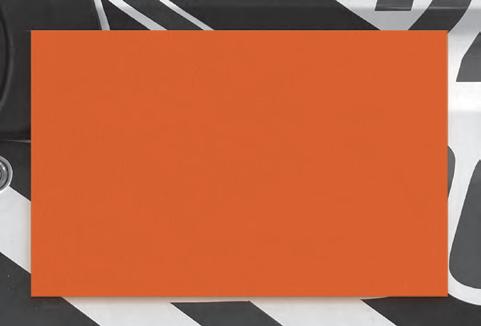
The penultimate section — the Time of Fear (Tempo do Medo) — leads visitors to confront various kinds of in timidating fears faced by people in Maré: loneliness, sickness, unemployment, hunger, rats, the storm, the rising tides at night, and the removal of dwellings. A panel formed by making plaster moulds of gunshot marks on walls was produced by teenagers who participated in workshops in the museum and high lights the most recent fears of violence, the stray bullet, drug wars, police operations, and brutal and pointless deaths. However, at the Maré Museum, fear does not have the last word. The exhibition ends by looking forward to the future and arguing that the future is built from today: through work, courage, engagement, dialogue and tolerance. But we must respect the struggles, the achievements and the memories of the residents that have gone before. Even in the face of fear, pain and anger, we collectively resist, and we
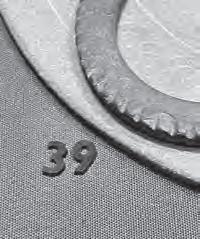
PEOPLE PLACE POWER
Since the beginning, dialogue, appreciation of diversity and exchange has been the basis of all the actions undertaken by the people working in this space. … We work to overcome stigma and to become an instrument for social transformation that is collectively built.

invent new possibilities for different futures.
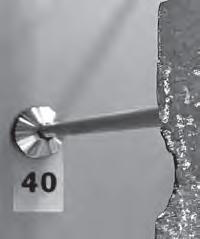
Since the beginning, dialogue, apprecia tion of diversity and exchange has been the basis of all the actions undertaken by the people working in this space. The museum’s political purpose is to establish bridges for communication with diverse realities, to challenge people, and to collaborate in or der to generate new perspectives for social transformation.

We work to overcome stigma and to become an instrument for social transforma tion that is collectively built.
Cláudia Rose Ribeiro da Silva Co-founder, C enter for Solidarity Studies Action, Maré (CEASM) and Coordi nator, Museu da Maré.
Museu da Maré: Museology from the Favela
Installation in the Museu da Maré: © Museu da Maré.
Tom Butler
So a part of yesterday crumbles into dust. That yesterday so sadly out of date for the changing needs of London.
CAPITAL CULTURE: MUSEUMS, CITIES, CULTURAL POWER
These are the opening words to ‘Capital Culture: Museums, Cities, Cultural Power’, a short film produced using archive record ings and found footage. The words are part of the original voiceover to a 1960s black and white film titled ‘The Changing Face of London’ that shows the post-World War II reconstruction of the city, but they could equally apply to any period of London’s history. Cities are always changing, and London is no exception.

Significant changes to any city’s built environment often, very reasonably, prompt questions from those who live and work there. Why are these changes happening? Who are they for? Such questions however are often allayed – or avoided altogether – when ‘culture’ is involved.
Culture and cultural institutions have long been at the heart of large urban developments, serving economic, political and social objectives. However, these cultural developments continue to raise questions about access, agency and intent.
Culture and cultural institutions have long been at the heart of large urban developments, serving economic, political and social objectives, and through an array of architectural expressions. However, these cultural developments continue to raise questions about access, agency and intent.
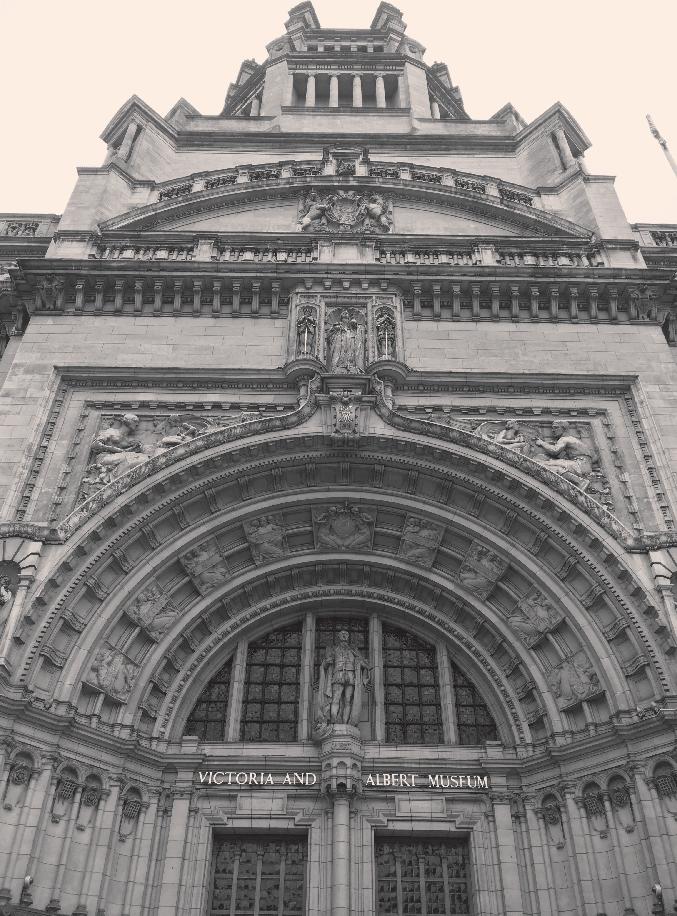
To situate these questions within Lon don, our film travels from west to east across the city looking at four cultural institutions that have been closely intertwined
 V&A South Kensington entrance: Tom Butler, 2021
Hayward Gallery across Waterloo Bridge: Tom Butler, 2022.
V&A South Kensington entrance: Tom Butler, 2021
Hayward Gallery across Waterloo Bridge: Tom Butler, 2022.
(although by no means uniquely) with the city’s development over the last 165 years: the V&A in South Kensington; the Hayward Gallery on the Southbank; Tate Modern on Bankside; and the Museum of London at London Wall and its future home in West Smithfield. These institutions and their buildings represent different models of ur ban change at different points in London’s history, as I will discuss.
The Great Exhibition of 1851 funded a new series of public buildings in South Kensington. This 87-acre complex trans formed a former garden suburb into a remarkable concentration of cultural and educational institutions that was an act of Imperial nation-building mirrored in its architectural expression. The South Kens ington Museum opened here in 1857, later becoming the Victoria and Albert Museum in 1899. It continues to adapt and evolve on this site, as well as to expand to other
We can begin to understand how powerful political, social, and economic drivers are expressed in the urban forms of cultural institutions, and the impacts they have both symbolically and materially.
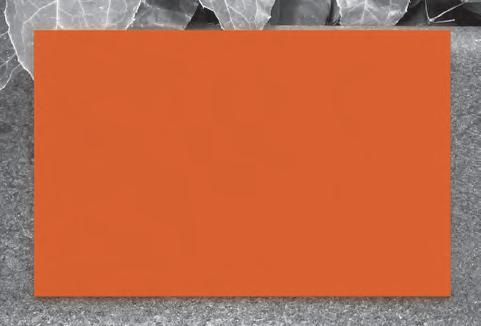

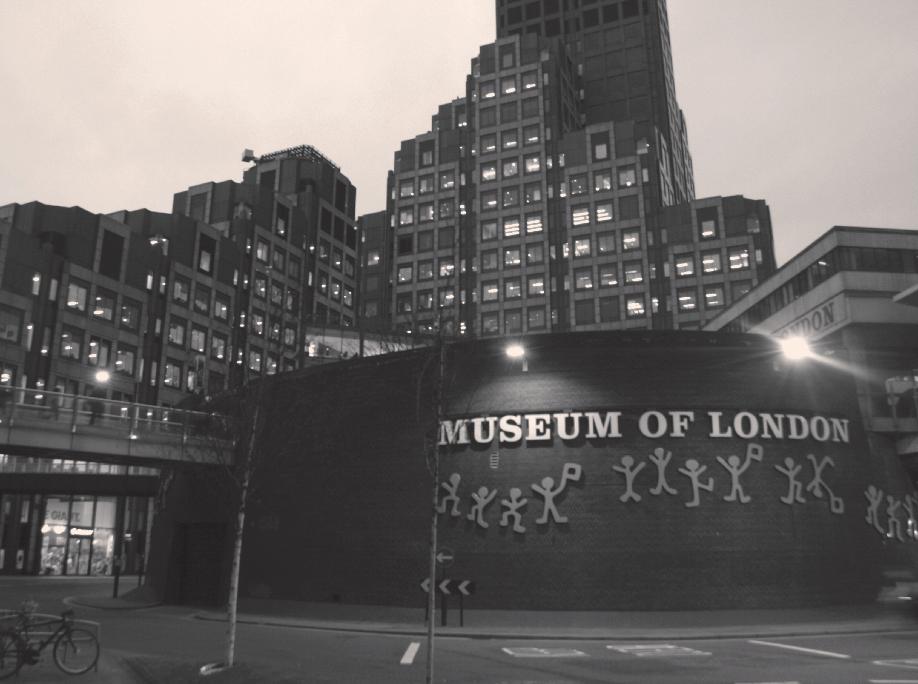

locations across London, including Bethnal Green and Stratford.
The Hayward Gallery opened in 1968 as part of the transformation of the South Bank. Its brutalist form presented a radical and uncompromising vision for the future, one whose lack of conventional building facades and multiple terraces continues to attract critics. Yet this ‘mound of urban concrete topography’, as architect Peter Clegg termed it during its 2018 restoration,
Capital Culture
Tate Modern interior: Tom Butler, 2022. Museum of London exterior from street level: Tom Butler, 2014
V&A South Kensington rotunda: Tom Butler, 2019
was conceived as an extension of the city in the way it was intentionally permeable, allowing diverse activities and cultures to populate its spaces.

Further downstream along the river Thames, Tate Modern was part of a global wave of cultural development projects in the 1990s and 2000s, exemplified by the Guggenheim Museum in Bilbao. At Bank side in London, ‘regeneration’ was the new rationale for large-scale development, within which culture was leveraged for its international reach as well as its urban impact. The transformation of the former coal- and oil-fired Bankside Power Station was hailed by architect Jacques Herzog as a ‘generator of urbanity’, whose location opposite London’s most iconic building, St Paul’s Cathedral, helped to strengthen its global credentials.
Over the Thames and in the heart of the City, the Museum of London opened in
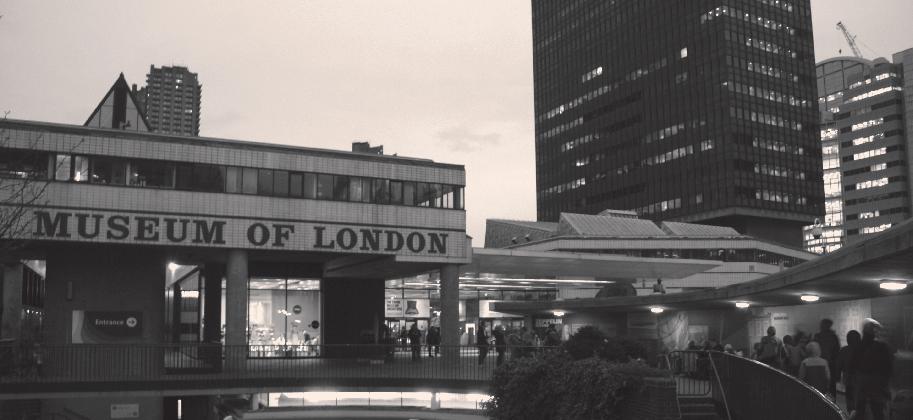

Cities have used museums to both tell their stories and to change them.
1976 as one of the final components of the Barbican development. However, what was once an idealistic new urban development has suffered from a lack of a connection to the street and its people. In 2026 the muse um will relocate to the previously derelict market buildings in West Smithfield. Despite being only a few hundred metres from the museum’s current site, this working part of London is a world away from the urban future imagined in the 1970s and set
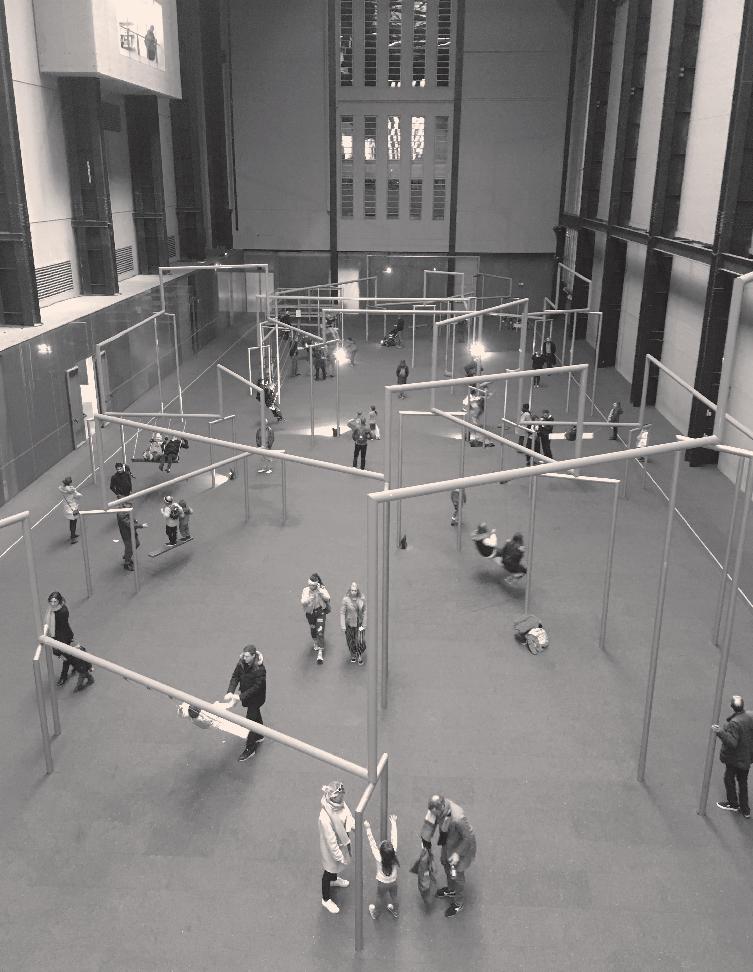
PEOPLE PLACE POWER
Hayward Gallery with London Eye: Tom Butler, 2022
Tate Modern interior, Turbine Hall with play equipment: Tom Butler, 2018
Museum of London entrance: Tom Butler, 2014.
Capital Culture


in concrete at London Wall. In Smithfield's Victorian-era General Market, the museum aims to create a new cultural space for the city. This vision of adaptive re-use has been contentious for some (including local mar ket traders) but presents a positive model of urban change for others.

Through these four examples we can begin to understand how powerful political, social, and economic drivers are expressed in the urban forms of cultural institutions, and the impacts they have both symboli cally and materially. The film ‘Capital Cul ture: Museums, Cities, Cultural Power’ is more of a provocation than an answer to the questions of agency, access and intent raised by culture-led urban developments. However, it provides a valuable compari son over a period of 165 years on the ways cities have used museums to both tell their stories and to change them.
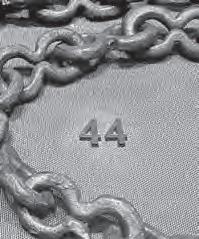 Tom Butler AHRC Doctoral Researcher, Brunel University London.
General Market, Smithfield. Corner of West Poultry Avenue: Tom Butler, 2020
General Market, Smithfield. Corner of Farringdon Road at night: Tom Butler, 2022.
Tom Butler AHRC Doctoral Researcher, Brunel University London.
General Market, Smithfield. Corner of West Poultry Avenue: Tom Butler, 2020
General Market, Smithfield. Corner of Farringdon Road at night: Tom Butler, 2022.
Series Editors
Ben Campkin, Rebecca Ross
Issue Editors
Monica Degen, Clare Melhuish, Lauren Parker
Co-ordinating Issue Editor
Isobel Ward
Graphic Design Bandiera, Guglielmo Rossi
With gratitude
Urban Pamphleteer is supported by UCL Urban Laboratory. Urban Pamphleteer #10 has been produced with support from Brunel University London, the Museum of London, and Arts Council England Printing Belmont Press Contact http://urbanpamphleteer.org email@urbanpamphleteer.org
Urban Pamphleteer
UCL Urban Laboratory Gordon House 29 Gordon Square London WC1H 0PY
Cover National Museum of the History of Immigration, Paris: Sophia Labadi, 2015.
Ben Campkin is Co-Director of UCL Urban Laboratory, Professor of Urbanism and Urban History at The Bartlett School of Architecture, and author of Remaking London (2013).
Rebecca Ross is MA Course Leader and Senior Lecturer in the Graphic Communi cation Design Programme at Central Saint Martins. She is the creator of the ‘London is Changing’ campaign (2015).
Back Issues
# 1 Future & Smart Cities # 2 Regeneration Realities # 3 Design & Trust # 4 Heritage & Renewal in Doha #5 Global Education for Urban Futures
# 6 Open Source Housing Crisis #7 LGBTQ+ Night-time Spaces # 8 Skateboardings # 9 Reimagining the Night
Available online at urbanpamphleteer.org
Thanks!
Central Saint Martins Graphic Communication Design
The Bartlett, UCL
We gratefully acknowledge the UCL Grand Challenges support that helped to initiate the Urban Pamphleteer series.
© 2022 All content remains the property of Urban Pamphleteer’s authors, editors and image producers. In some cases, existing copyright holders have granted single use permissions.
ISSN 2052–8647 (Print) ISSN 2052–8655 (Online)
@urbanpamphlet
September 2022
Monica Degen is Professor in Urban Cultural Sociology at Brunel University London, Prin cipal Investigator on the Sensory Smithfield research project, and primary co-ordinator of the Museums, Cities, Cultural Power sympo sium, June 24th 25th 2021.
Clare Melhuish is Director and Principal Research Fellow at UCL Urban Laboratory, which partnered with Brunel University and the Museum of London to produce the Muse ums, Cities, Cultural Power 2021 symposium.
Lauren Parker is Head of Creative Partner ships at the Museum of London, part of a team building a new Museum of London in West Smithfield, featured in this issue.
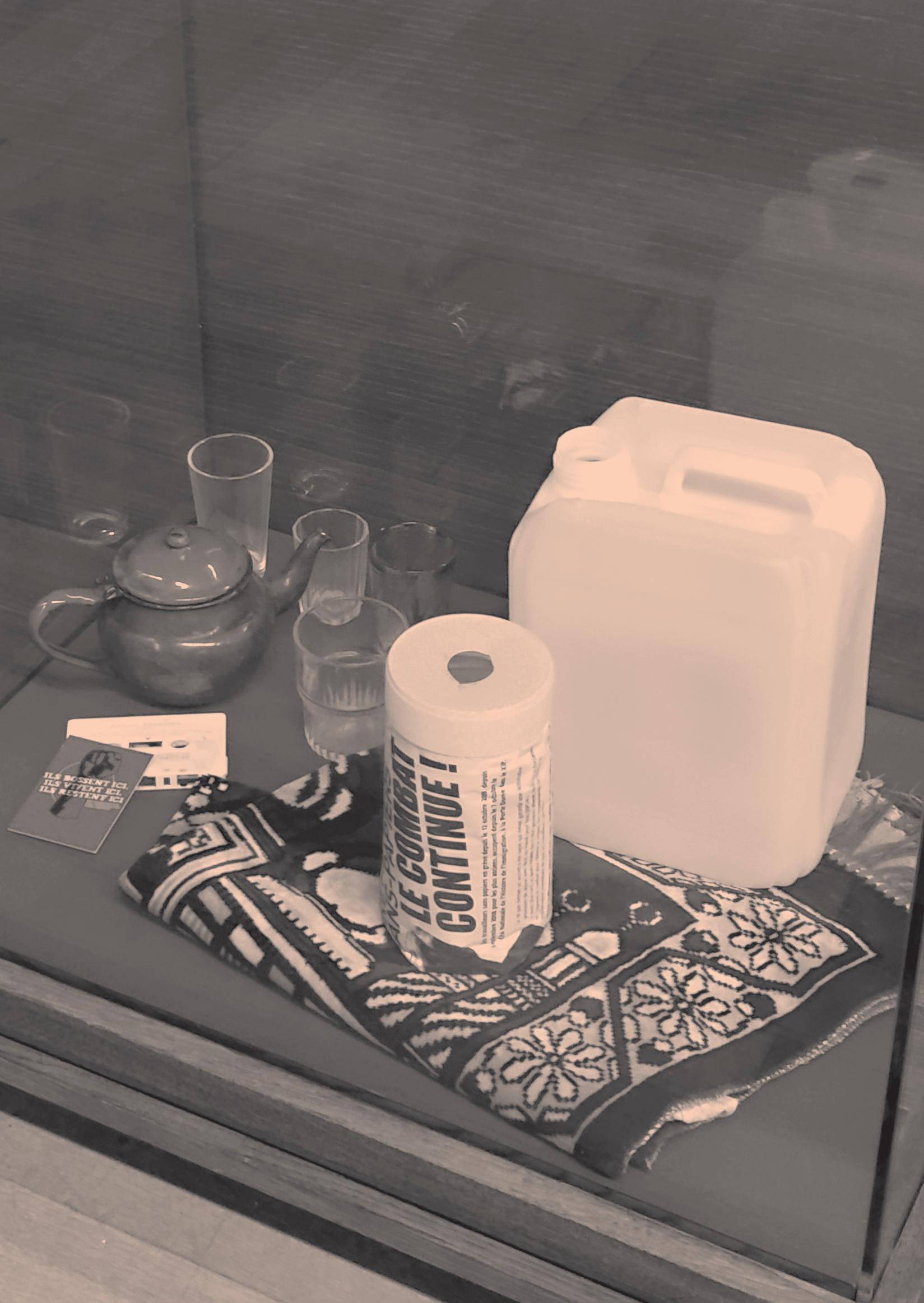








 The City as a Site of Direct Action
Carla Ecola, Director of Outside Project, lays candles at Museum of Homelessness vigil, 2021: Anthony Luvera.
Museum of Homelessness COVID-19 Homeless Taskforce in May 2020: Matt Turtle.
The City as a Site of Direct Action
Carla Ecola, Director of Outside Project, lays candles at Museum of Homelessness vigil, 2021: Anthony Luvera.
Museum of Homelessness COVID-19 Homeless Taskforce in May 2020: Matt Turtle.
















 1 S. Labadi, Museums, Im migrants and Social Justice.
Museums, Undocumented Workers and Social Justice
Glass cabinet displaying objects from the occupation of the NMHI: Sophia Labadi, 2015
1 S. Labadi, Museums, Im migrants and Social Justice.
Museums, Undocumented Workers and Social Justice
Glass cabinet displaying objects from the occupation of the NMHI: Sophia Labadi, 2015











 The Centre for Contemporary Culture Barcelona
Map showing location of the CCCB in el Raval, Barcelona: OpenStreetMap, 2022.
The Centre for Contemporary Culture Barcelona
Map showing location of the CCCB in el Raval, Barcelona: OpenStreetMap, 2022.





















 Film stills from 06:30, 2021, commissioned by City of London: © Larry Achiampong. All rights reserved, DACS/Artimage 2021. Courtesy of the Artist and Copperfield London.
Film stills from 06:30, 2021, commissioned by City of London: © Larry Achiampong. All rights reserved, DACS/Artimage 2021. Courtesy of the Artist and Copperfield London.
 Stephen Pritchard
Stephen Pritchard


 Still from the film A Cacophony of Crows, directed by Stephen Pritchard, 2018.
Still from the film A Cacophony of Crows, directed by Stephen Pritchard, 2018.








 Claudia Zaldívar
Claudia Zaldívar












 Museo de la Solidaridad Salvador Allende
Claudia Zaldívar Director, Museo de la Solidaridad Salvador Allende.
Participation of the Museo de la Solidaridad Salvador Allende in the Interna tional Women's Day march. Santiago, Chile: Lorna Remmele, MSSA archive, March 8th 2020
Inauguration of the Tejido Social Exhibition. Museum of Solidarity. Santiago, Chile: Lorna Remmele, MSSA archive, April 30th 2019
Pedro Fiori Arantes
Museo de la Solidaridad Salvador Allende
Claudia Zaldívar Director, Museo de la Solidaridad Salvador Allende.
Participation of the Museo de la Solidaridad Salvador Allende in the Interna tional Women's Day march. Santiago, Chile: Lorna Remmele, MSSA archive, March 8th 2020
Inauguration of the Tejido Social Exhibition. Museum of Solidarity. Santiago, Chile: Lorna Remmele, MSSA archive, April 30th 2019
Pedro Fiori Arantes











 Museum of Image and Sound (under construction), Copacabana, Rio, 2009—present: © DS + R
Museum of Image and Sound (under construction), Copacabana, Rio, 2009—present: © DS + R







 Open air Museum of Evictions. The banner reads – Memory cannot be evicted: © RioOnWatch/Catalytic Communities.
Open air Museum of Evictions. The banner reads – Memory cannot be evicted: © RioOnWatch/Catalytic Communities.








 V&A South Kensington entrance: Tom Butler, 2021
Hayward Gallery across Waterloo Bridge: Tom Butler, 2022.
V&A South Kensington entrance: Tom Butler, 2021
Hayward Gallery across Waterloo Bridge: Tom Butler, 2022.











 Tom Butler AHRC Doctoral Researcher, Brunel University London.
General Market, Smithfield. Corner of West Poultry Avenue: Tom Butler, 2020
General Market, Smithfield. Corner of Farringdon Road at night: Tom Butler, 2022.
Tom Butler AHRC Doctoral Researcher, Brunel University London.
General Market, Smithfield. Corner of West Poultry Avenue: Tom Butler, 2020
General Market, Smithfield. Corner of Farringdon Road at night: Tom Butler, 2022.
